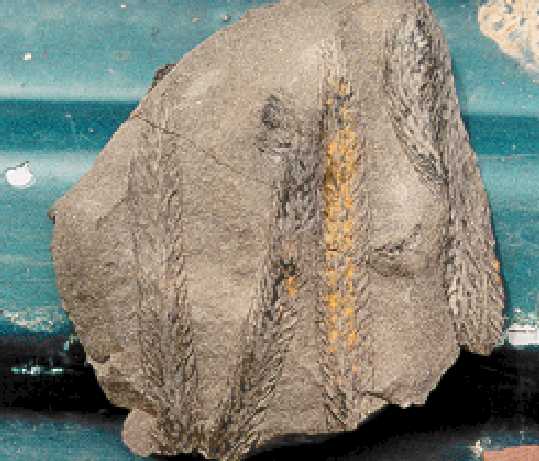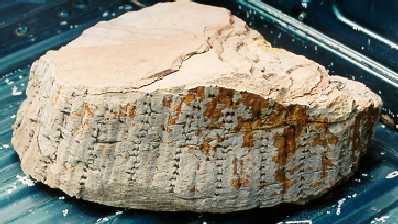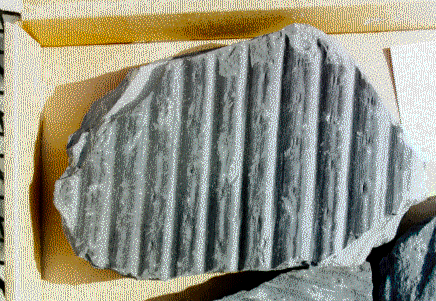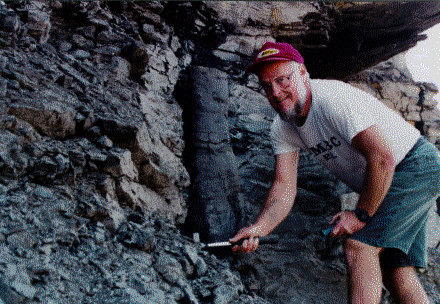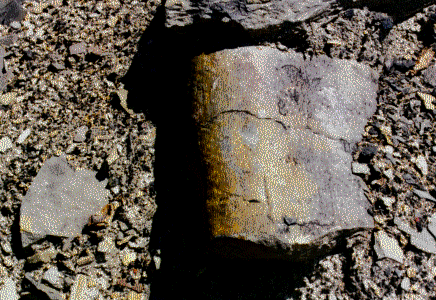The gang
Visitor
fern
IMG_6064
Larry pried off the part of this rock containing the lepidodendron fossil, and found this mass of ferns on the back. He'll have a difficult time figuring out which side to display!
March 29, 2008 - Pennsylvanian Fossils - Walker and Jefferson County, AL
This month BPS spent our field trip exploring road cuts along a new highway, which included 10+ stops to survey various likely looking areas. Though rain was widely predicted, it didn't happen, and the weather was perfect for being outside. The fossil collecting wasn't as prolific as expected, but everyone found quite a few nice specimens, including brachiopods, tracks, and ferns. We also discovered an upright hole that appeared on first glance to be a blasting hole, but on closer examination one could see the impression of a lycopod, perhaps a lepidodendron. Several people worked on an exposed rock shelf where an extensive plate of fossil marine creatures were found.
We also had a quick visit from a couple of guys from North Alabama, who were passing through the area, and stopped to see what we were doing. Amazingly, they had just seen the BPS website the previous week, and were excited to see us out in the field.
Mid-day, we stopped at a local BBQ joint for nourishment and visiting, and then slowly proceeded in the general direction of home, stopping at roadcuts on the other side of the road. We searched carefully for more starfish at the location where they were originally found, but none were spotted this time. As members drifted off home, a few die-hards kept going until almost dark. Our last stop of the day was a construction site, where some pieces of poor quality petrified wood was found.
(Photos courtesy Vicki Lais)
- ‹ previous
- 2 of 2
February 18, 2006 - Pennsylvanian Fossils, Bibb and Shelby Co, AL
Another trip not put off for "rain, nor sleet, nor snow etc." Near-freezing temperatures, 100% chance of rain, an overcast sky and icy drizzle to begin the day were all on the menu at the BPS field trip in February to strip-mine sites in Bibb and Shelby county. To give you an idea of what we decided to brave, our host at our first stop, an active coal washing site, didn't show up until we called him, because he thought that nobody in their right mind would be out there! Well, you know, as Nancy remarked, "Once you start finding things, you forget how cold you are!" And this from somebody wearing a "Teenage ninja fossil-hunter suit." Of course, all were outfitted in attractive hard-hats, an MSHA requirement for visits to active mining sites. Just try keeping those on while bending over to find bits and pieces of neat stuff!!! Next time, we should bring little elastic strings to hold them on! Perhaps we should have been wearing them on the parts of our anatomy most-often turned towards the sky!
So, there were the most hard-core of the BPS'ers, happily finding plenty of plant fossils. Our first site was at a coal washing facility, where a variety of plant material was found, including numerous stem impressions, casts, and parts of tree ferns. Excited cries, of "Wow, look at this one!" made it hard to leave for the next site, an abandoned mine a few miles back in the woods, but, the word that we could lose the hardhats, among other attractions, won the gang over.
The second site was in the boonies, even for that area of the state, way down a long dirt road through the woods, through a locked gate, near where a prison used to house people who were busting rocks against their will, so to speak. This second site was very prolific, and members found tree ferns, calamites, and a few tree fern seeds. Some very nice specimens were found, including new "doorstops" for some members.
It was decided to move on to a third site, but the road was too muddy for us to drive up to it. This must be a good place, though, because at least one nice specimen was found near the entrance: a beautiful little silhouette of lacy fern leaves from so very long ago.
One more stop, to look at a site containing remains of bark impressions and calamites casts. There were some nice tree fern specimens in very fragile, easily crumbled rock. A number of fossils were in rocks too large to lug home, and our hands were too frozen, anyhow! Then we finally decided it was time to think about heading home for hot baths, hot laundry, hot food and a nice, long rest. Maybe our next trip will be graced with sunshine and gentle breezes!
--Edited by Vicki Lais
(photos courtesy Vicki Lais)
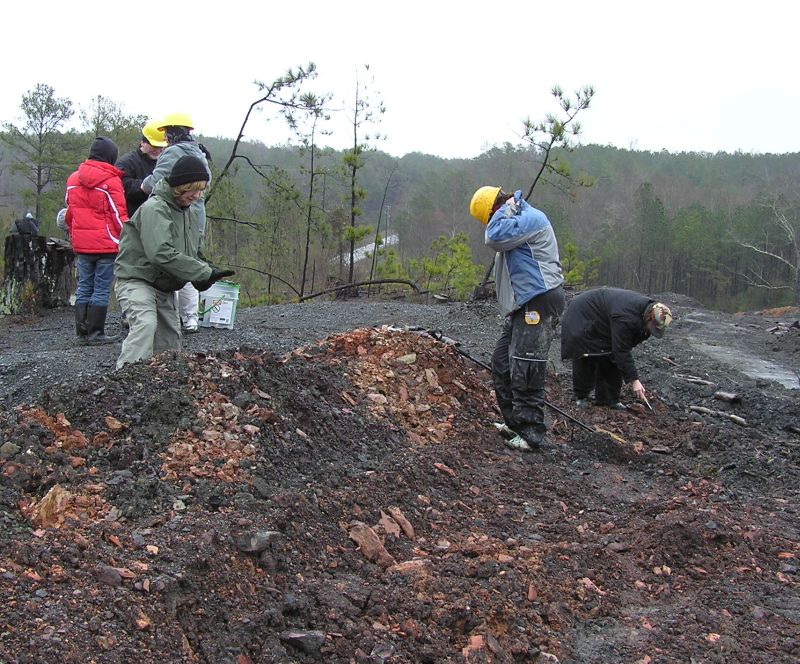
Some of the group on top of a spoil pile.
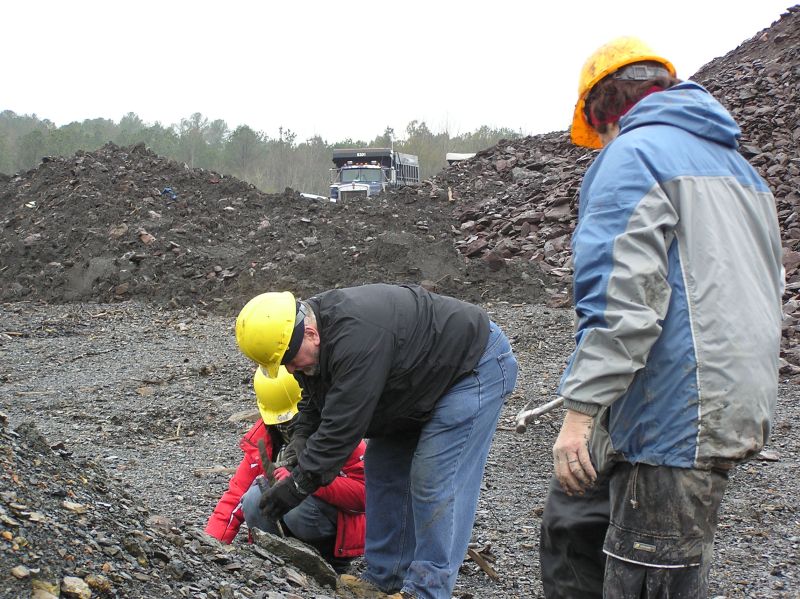
Greg demonstrating how to get the fossil out safely without taking home the entire rock.
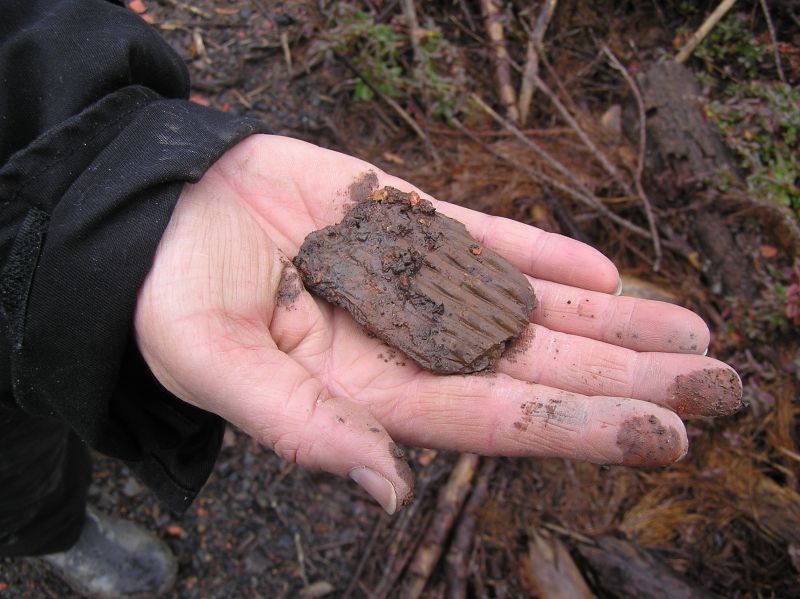
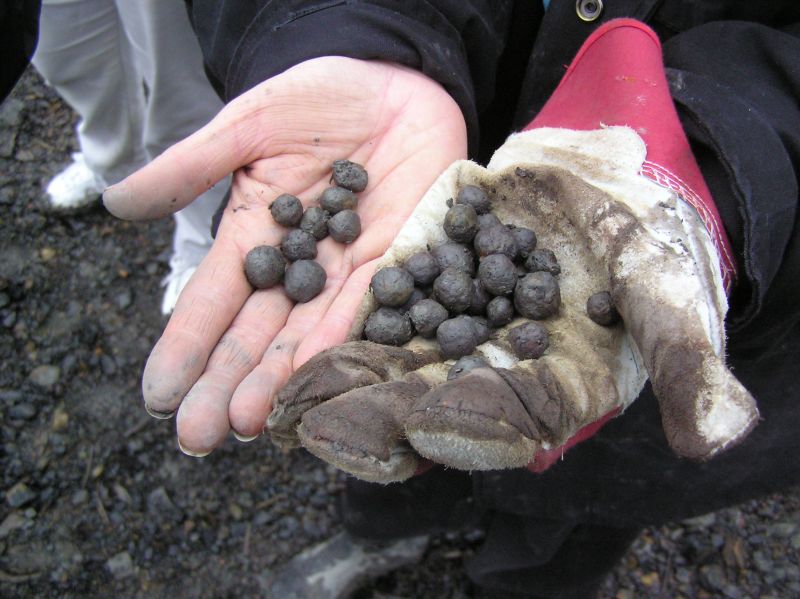
Small balls of iron ore used in the ironmaking process. These apparently date to the 1940's and 50's when coal mines in the area were in full force and trains carried various materials between the mines and the steel plants.
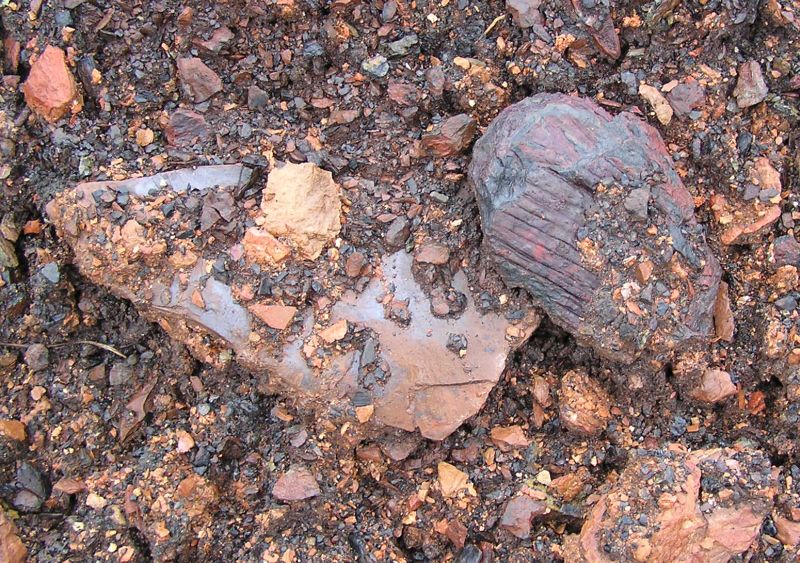
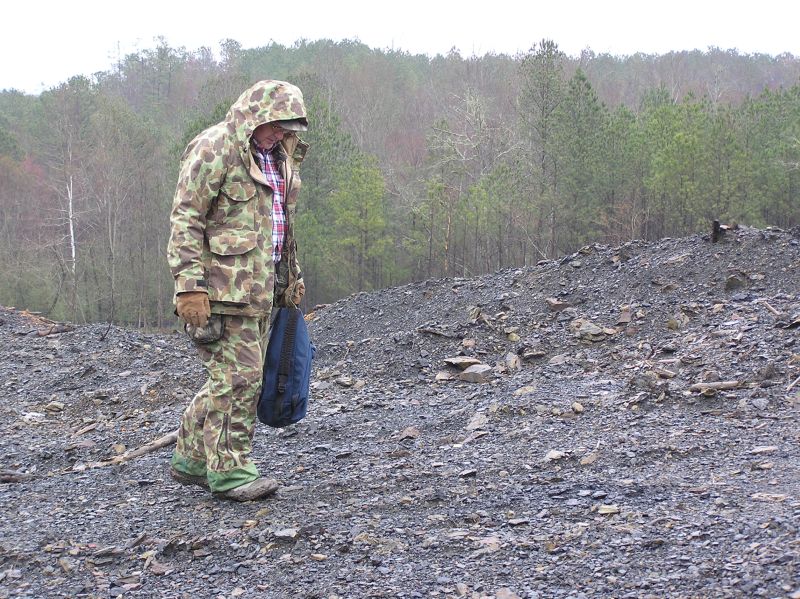
Bill searching for more fossils.
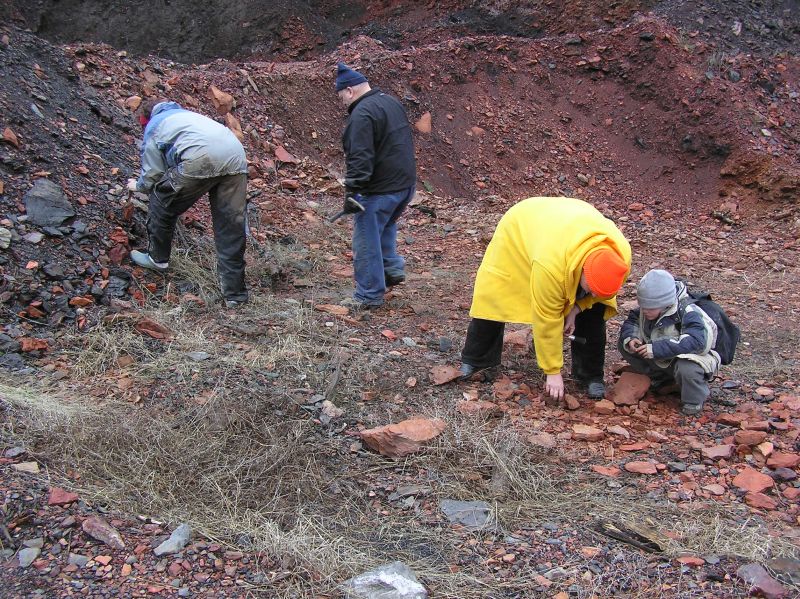
At our second site, many of the rocks were red rather than gray. This was due to the rocks being "burned" at some time in the past, perhaps with a smouldering coal fire.
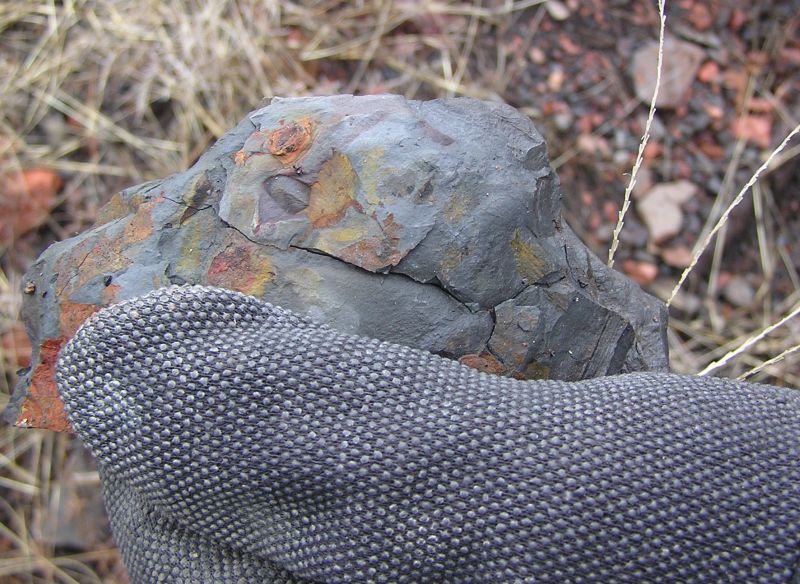
Nice "tree fern" seed fossil found by Greg.
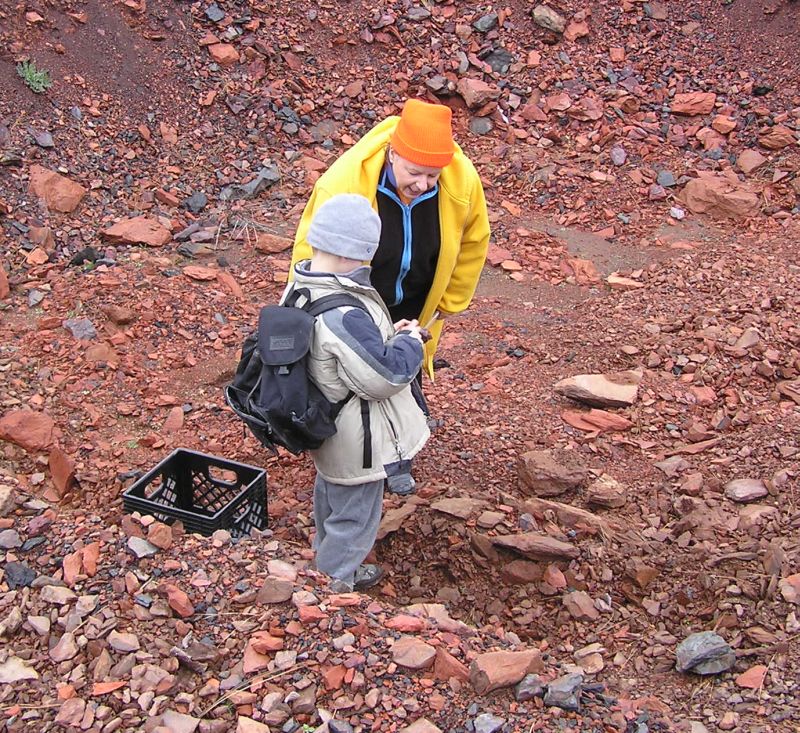
Leisa helping identify the fossil Ryan has found.
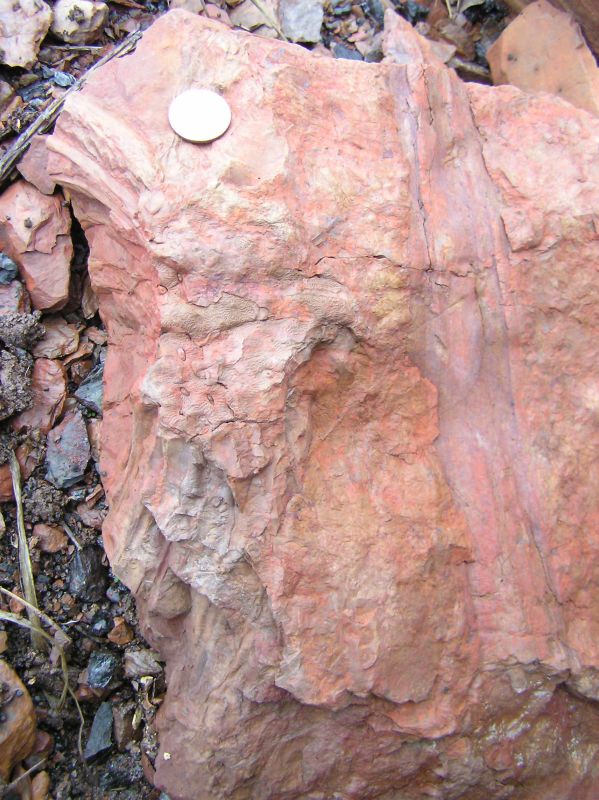
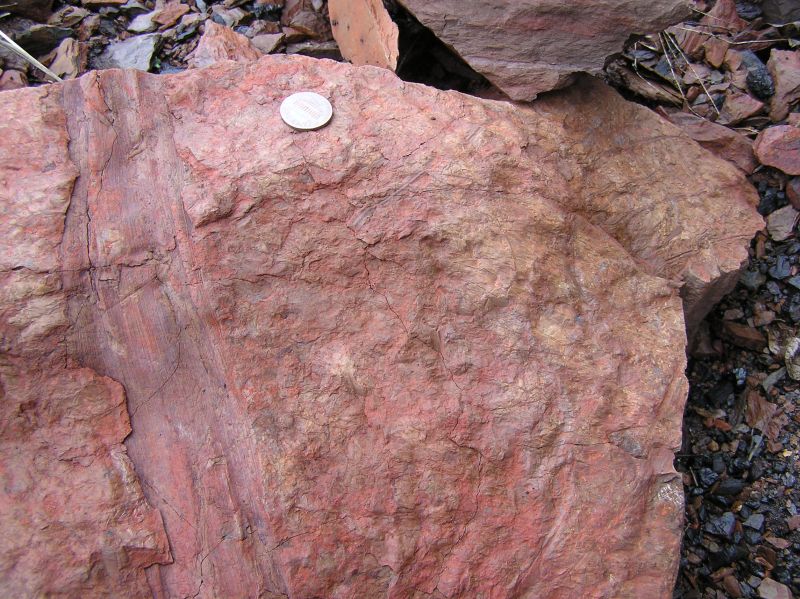
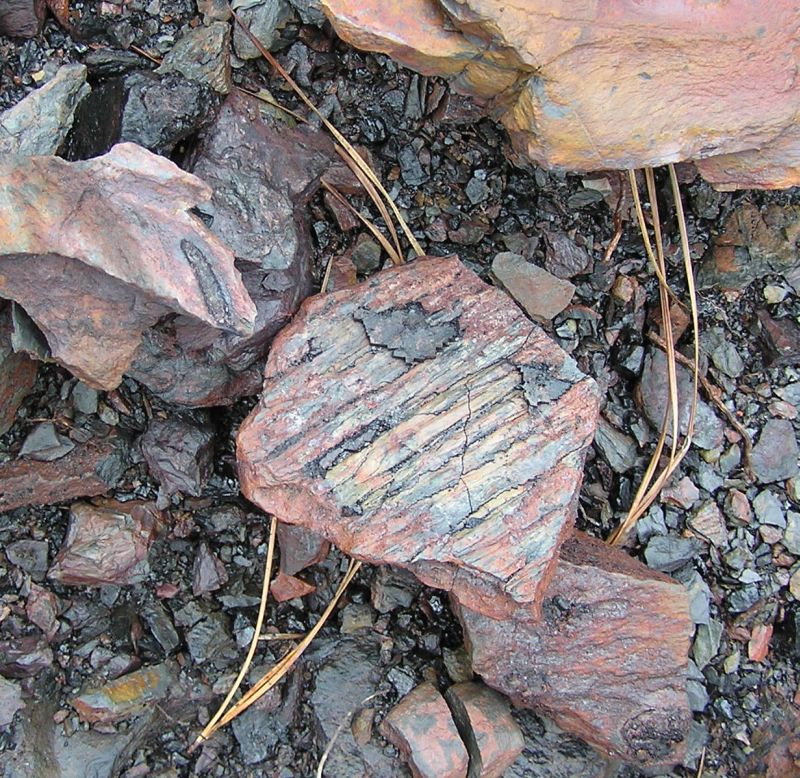
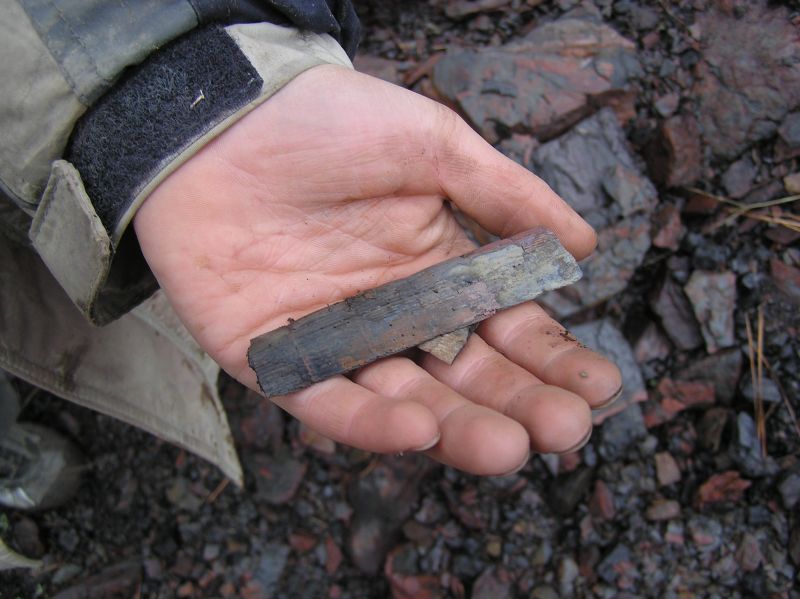
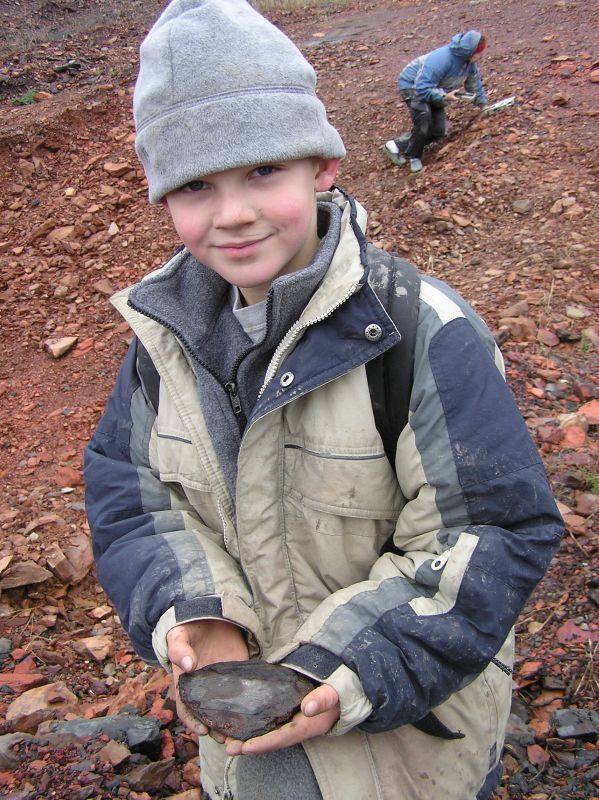
Ryan has found a nice fossil.
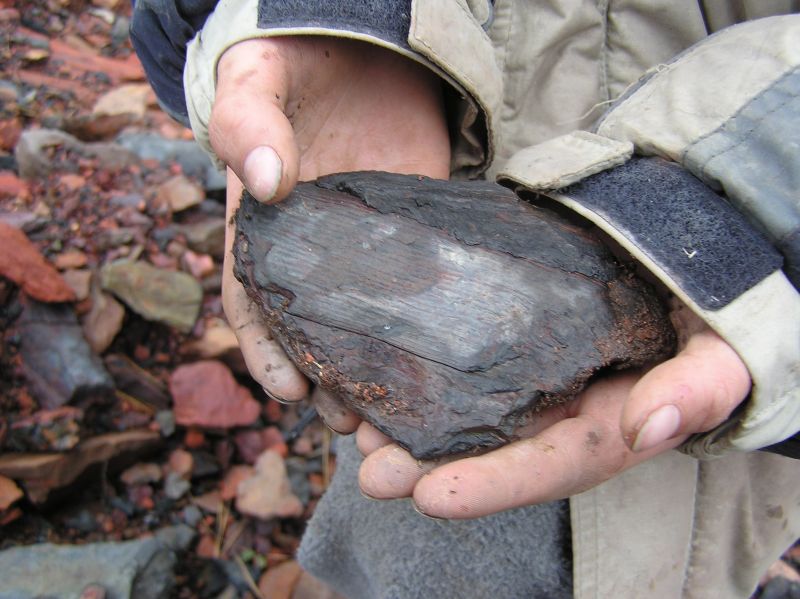
A closer look at the calamites Ryan has found.
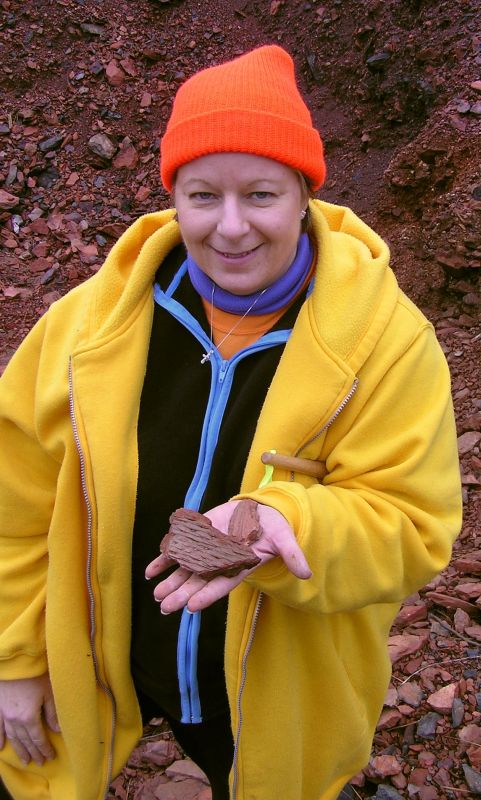
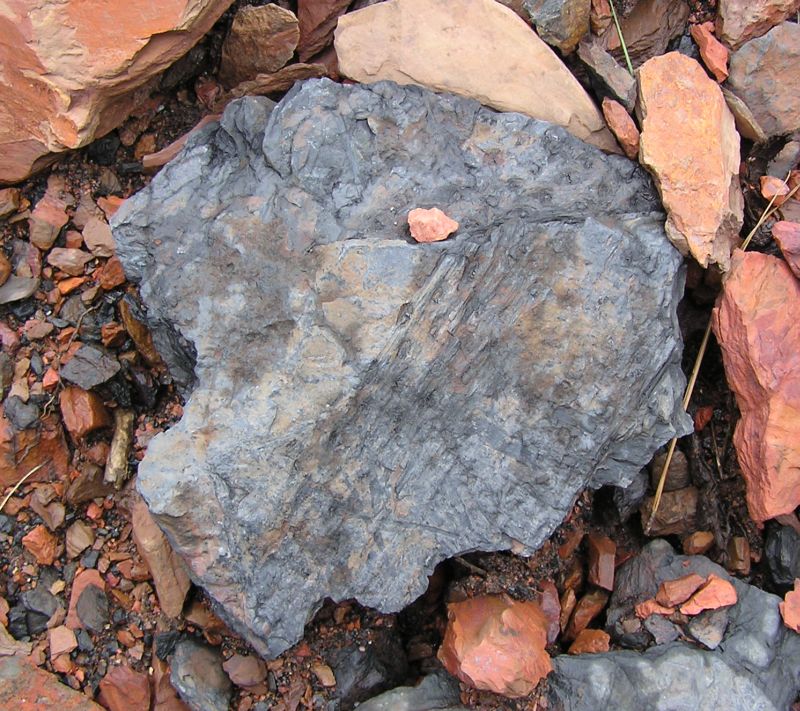
Stigmaria (roots of a Lycopod, possibly Lepidodendron)
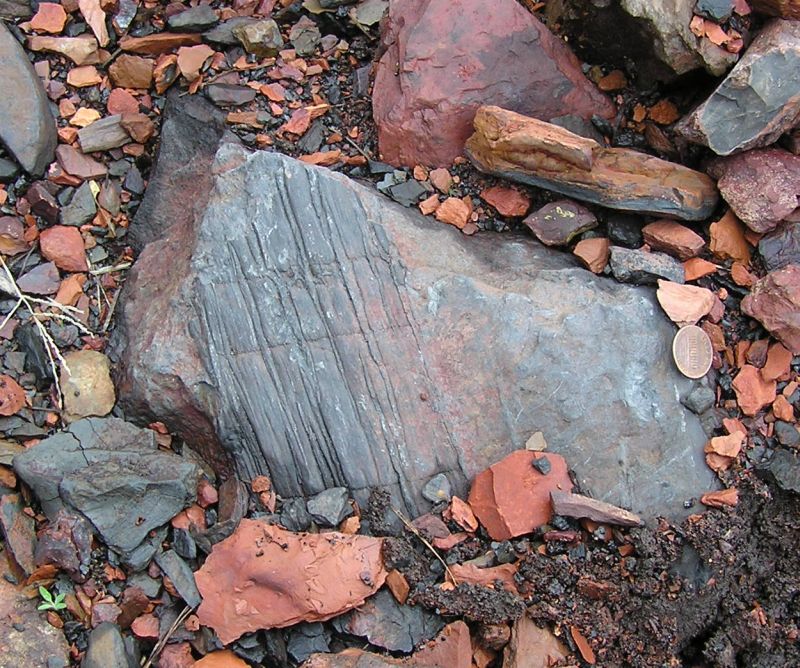
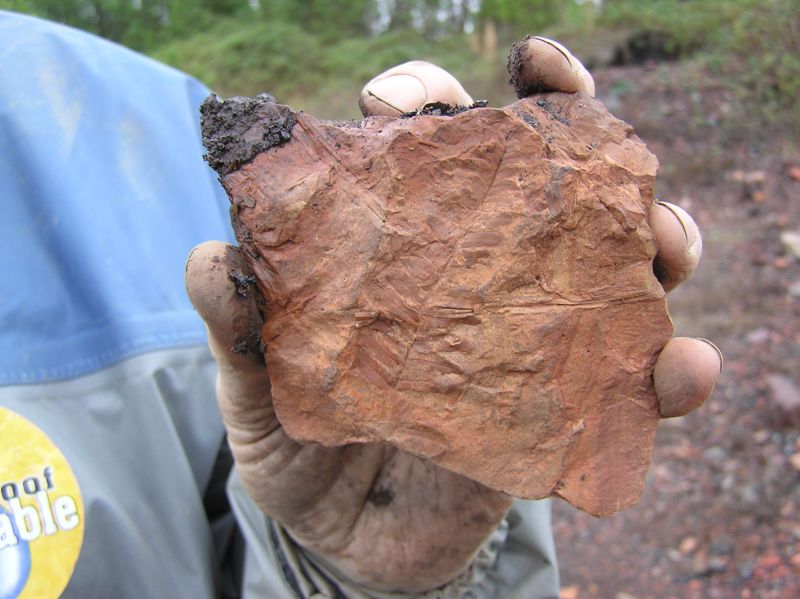
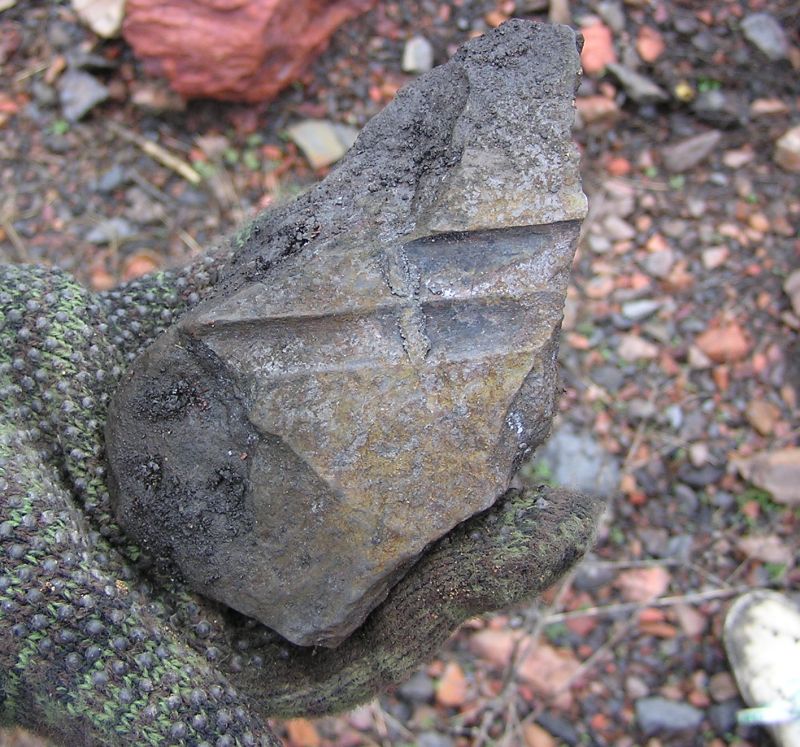
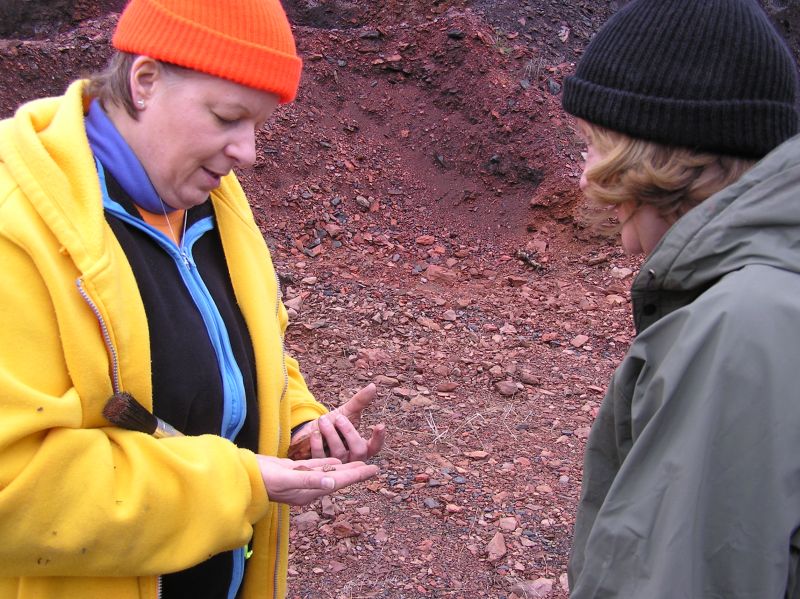
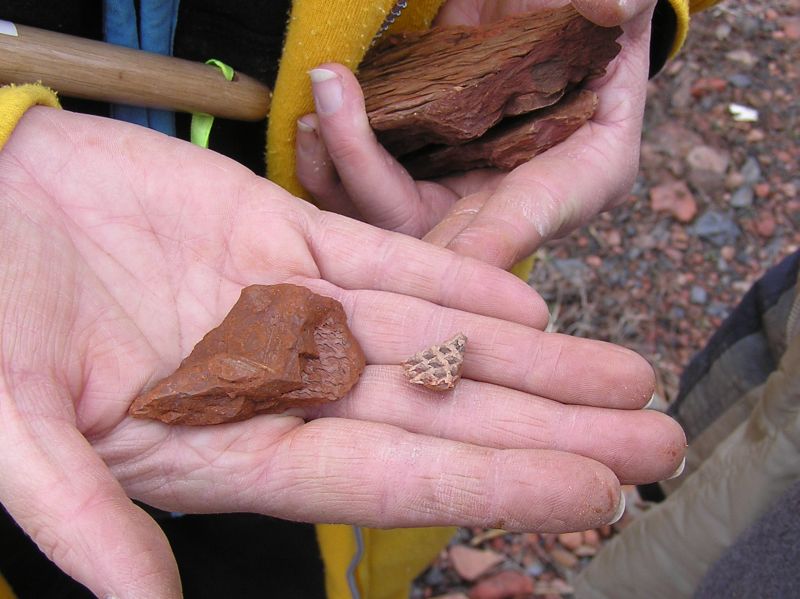
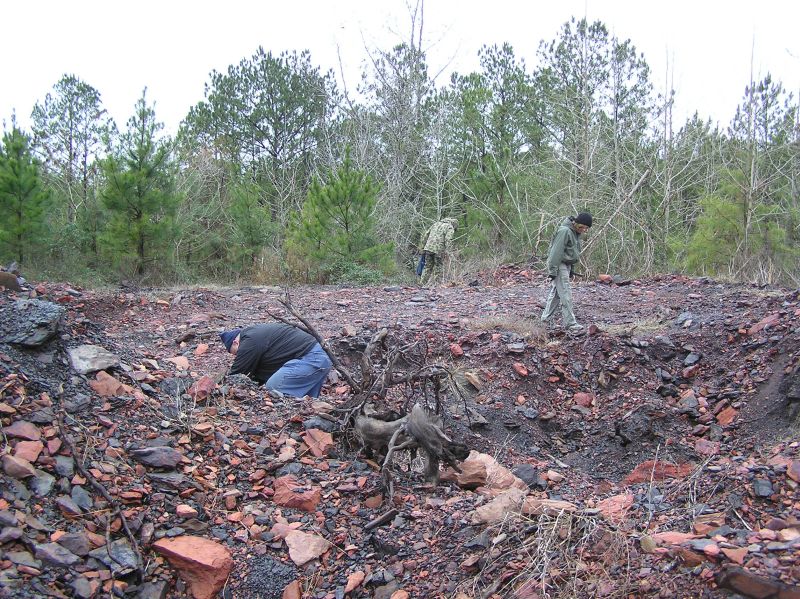
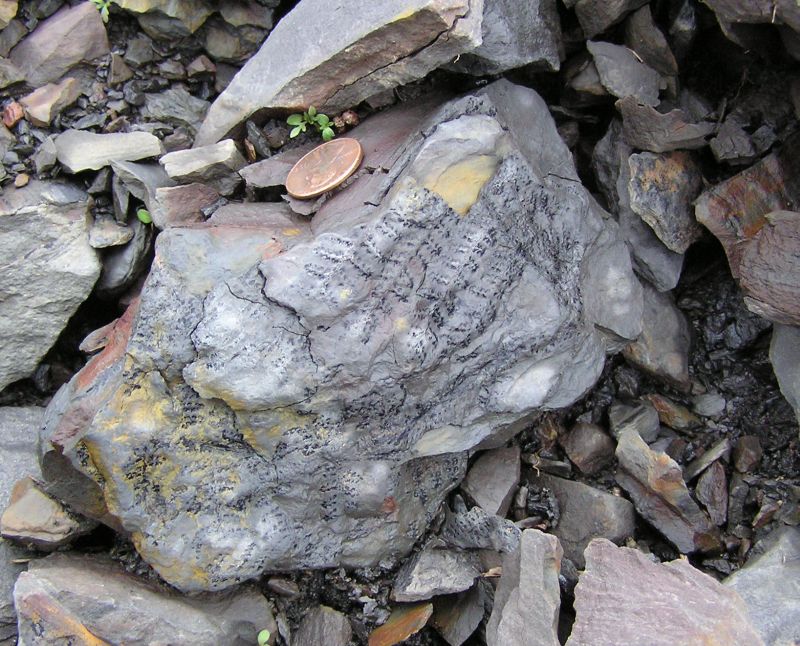
Nice fern, possibly Sphenopteris.
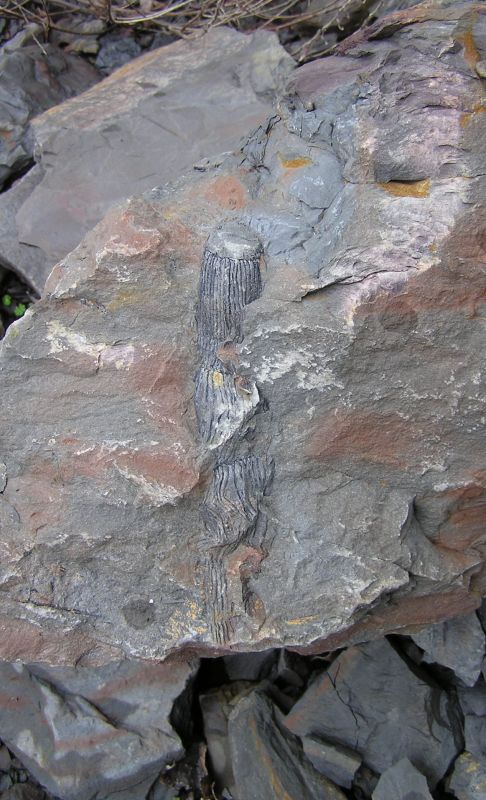
Calamites stem cast.
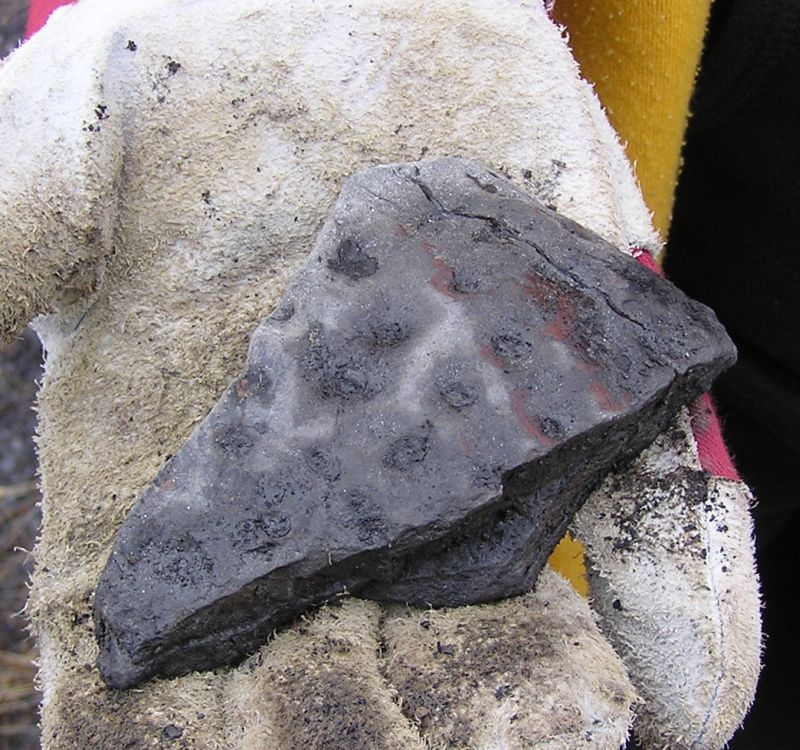
Probably Stigmaria, a lycopod root.
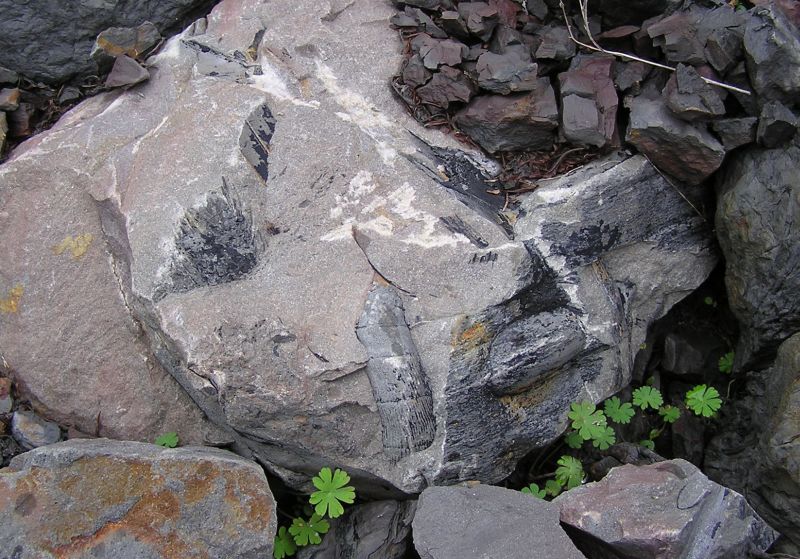
Calamites stem cast.
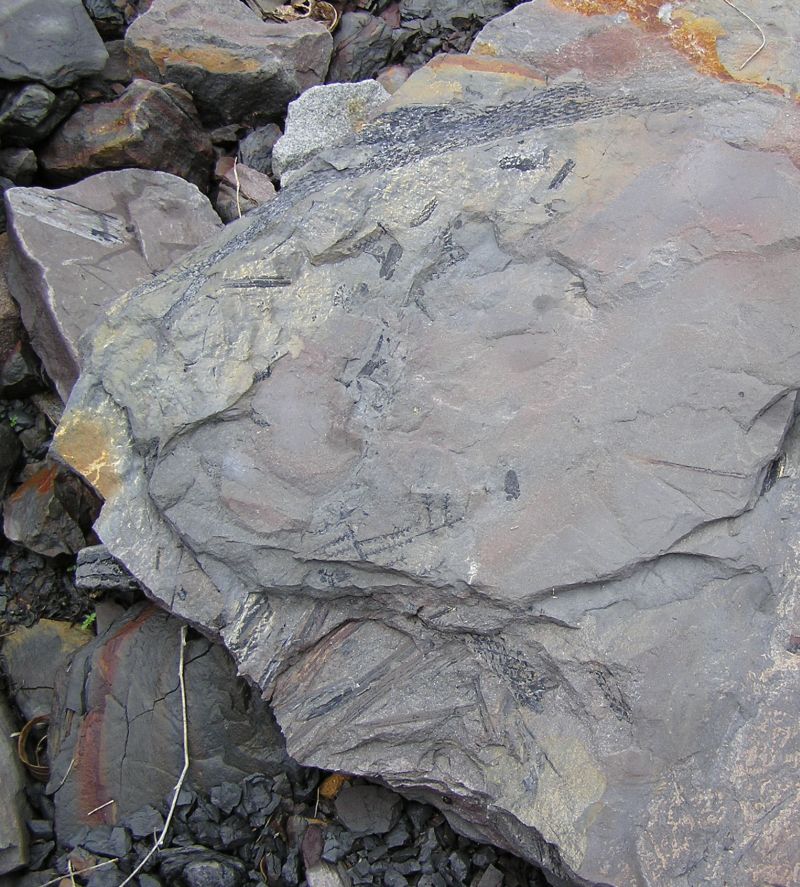
Tree fern outer stem covering and fern-like leaves, probably Sphenopteris.
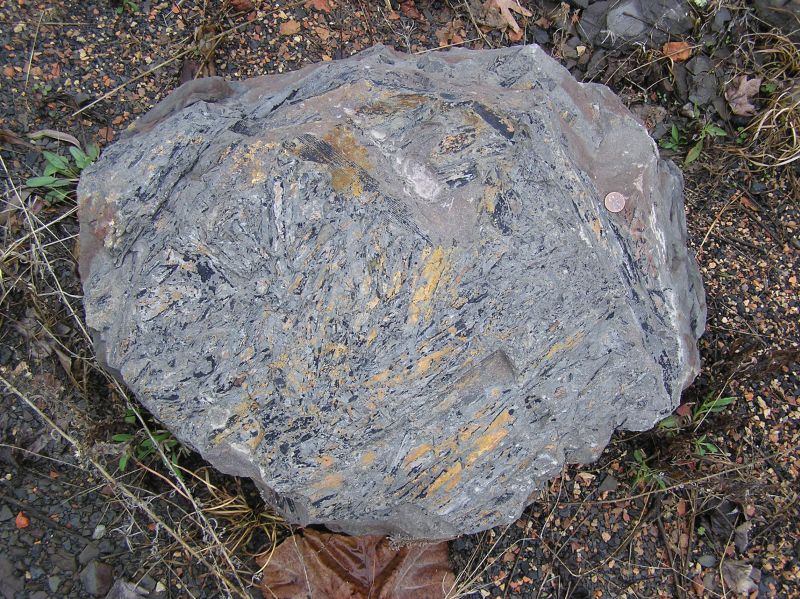
A hash of leaves and stems.
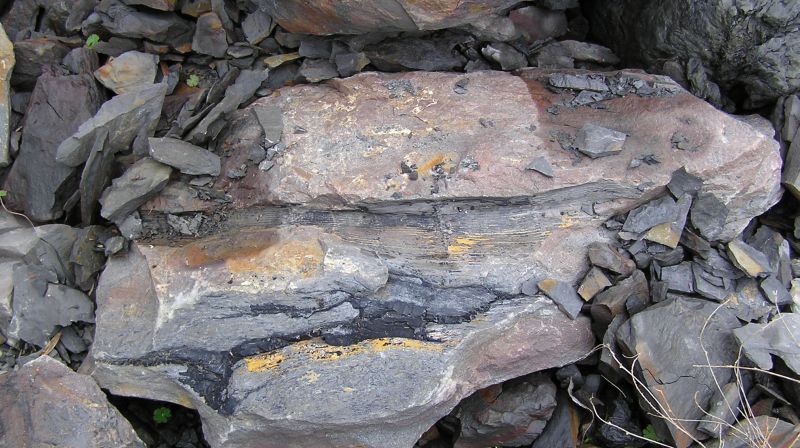
Calamites stem cast.
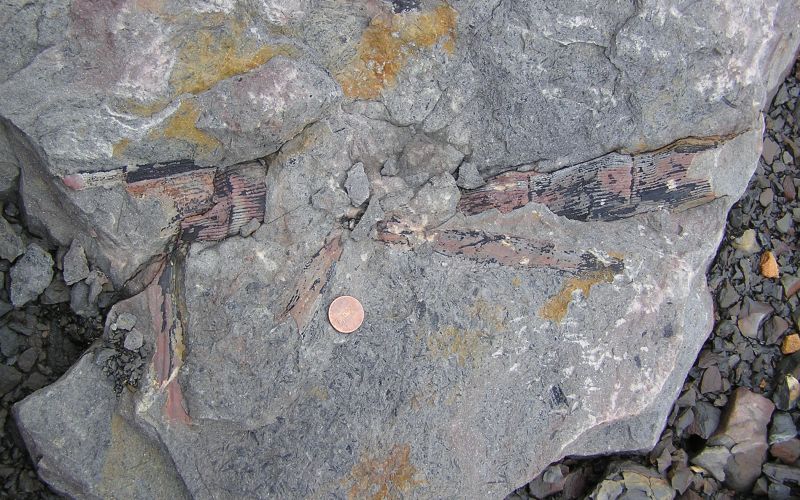
Nice calamites stem.
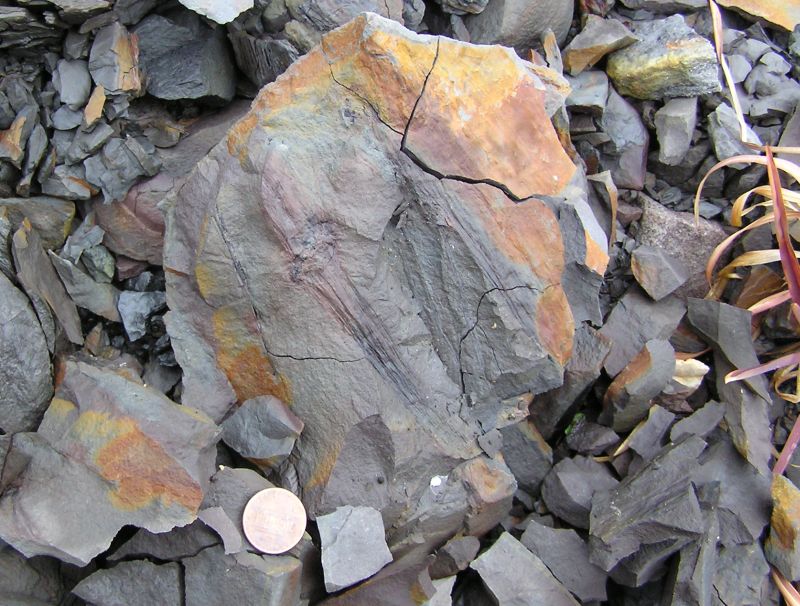
June 21, 2003 - Carboniferous Fossils, Jefferson Co, AL
BPS members visited 2 areas of new road development and a small quarry in Jefferson County this month, making 3 stops total. We had not visited these locations before, so were not sure how prolific the sites would be.
(Photos courtesy Greg Mestler, Ron Beerman, and Vicki Lais.)
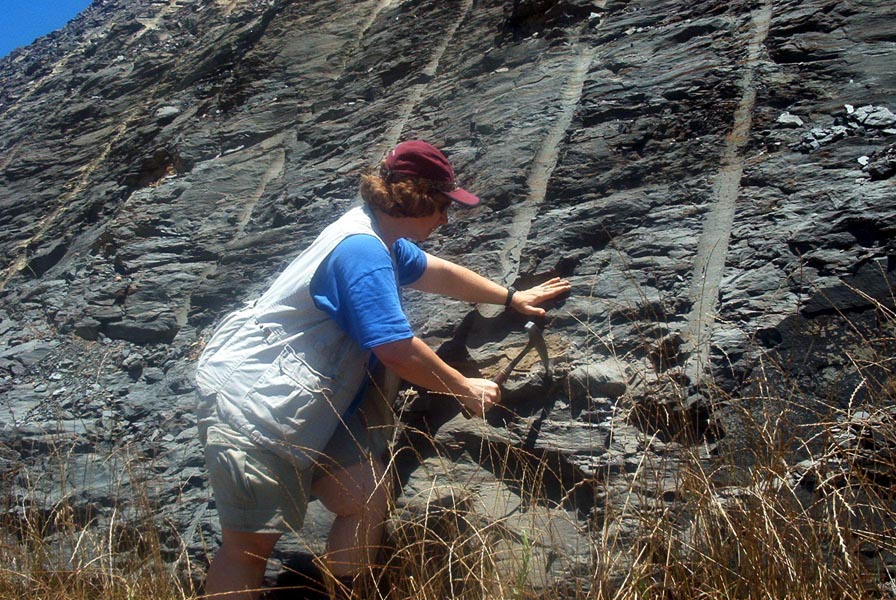
At stop #1, several brachiopods and a couple of slabs with small amphibian track prints were found.
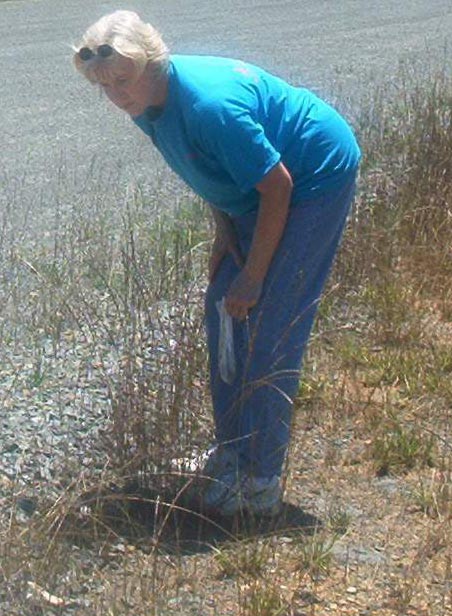
Jan found a number of brachiopods at this spot.
At stop #2, a number of nice limpets (gastropods) were found.
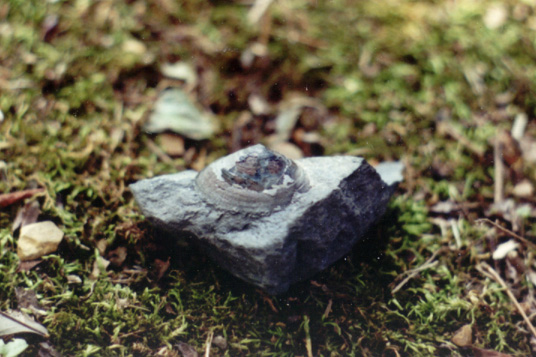
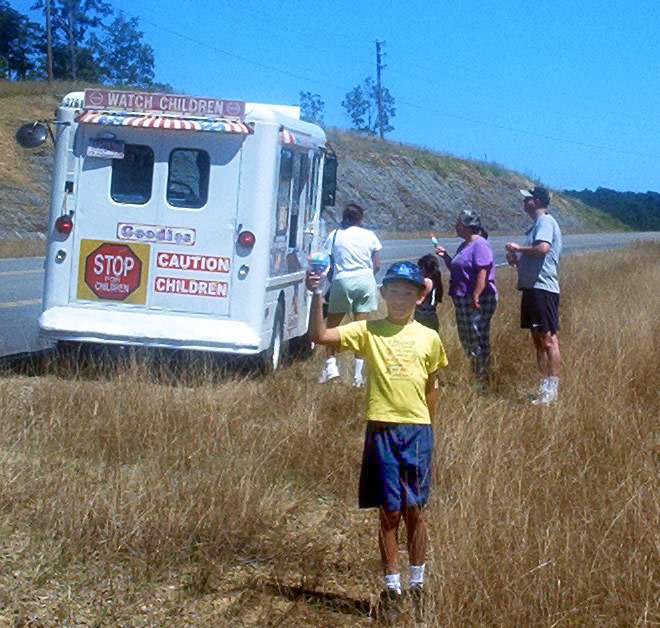
How's this for service? First time we ever had roadside delivery!
At stop #3, a number of plant fossils were found at a local quarry.
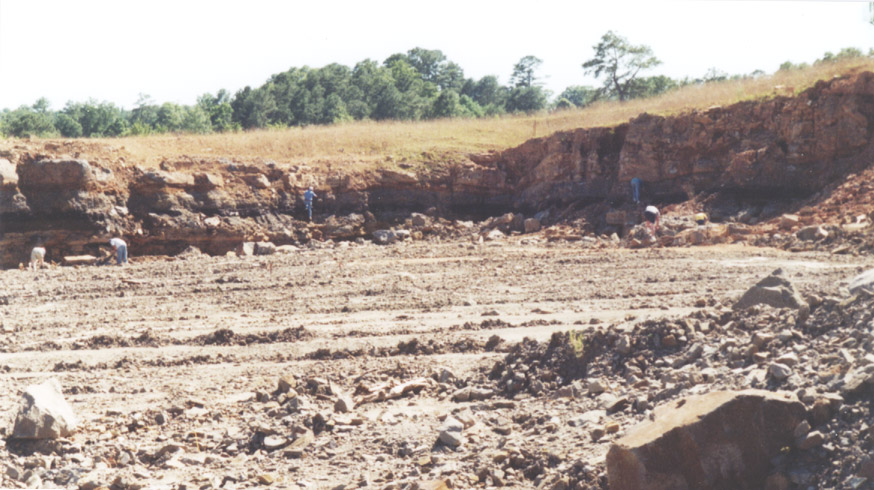
|
Picture of Calamites found just above a coal seam at one of the sites visited. It measures 101mm in diameter (approx 4 inches) and 304 mm (12”) in length. This cast of the central pith-cavity of the trunk is a very common fossil of Calamites. It is characterized by the articulation and the vertical ribbing between the nodes. The ribs are the imprints of the vascular strands. It measures 101mm in diameter (approx 4 inches) and 304 mm (12”) in length. This tree, in size up to 20 meters, grew during the Carboniferous period, about 320-350 million years ago. (This specimen found by Ron, Claire got the other half, which is about the same size.) |
|
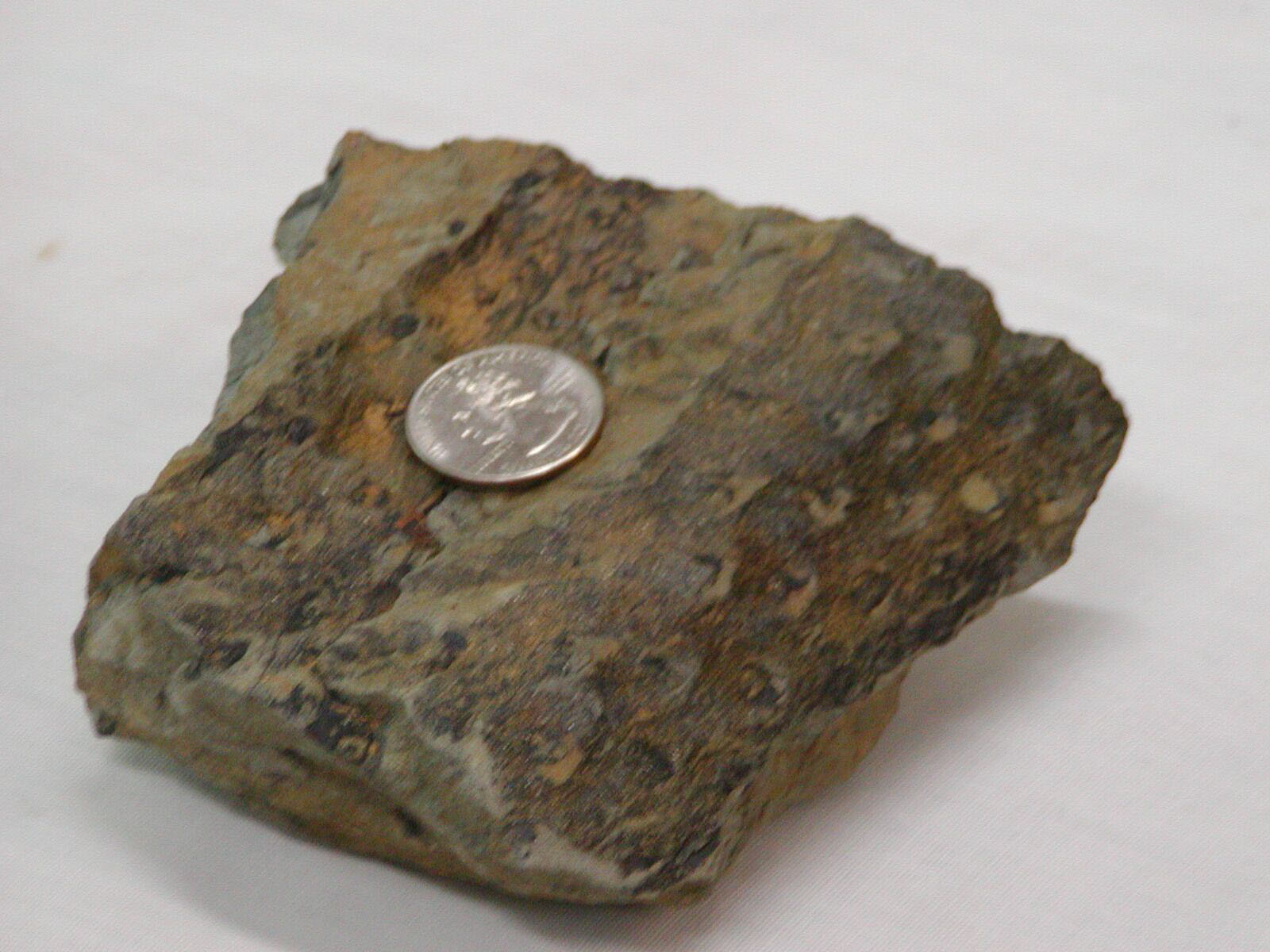
Stigmaria Ficoides. This is a fossilized root of the Sigillaria tree. This piece measures 102 mm by 114 mm. It was found near a coal seam. This plant lived during the Pennsylvanian Period of the Paleozoic Era 320-350 mya around swamps or lakes grew to several meters in height. Its modern day relatives are the small club mosses and lycopods. The round nodes on the surface of stigmaria are scars where rootlets were once attached and arranged in a radial fashion about stigmaria like the bristles of a bottle brush. During their life these trees shed parts of their outer bark.
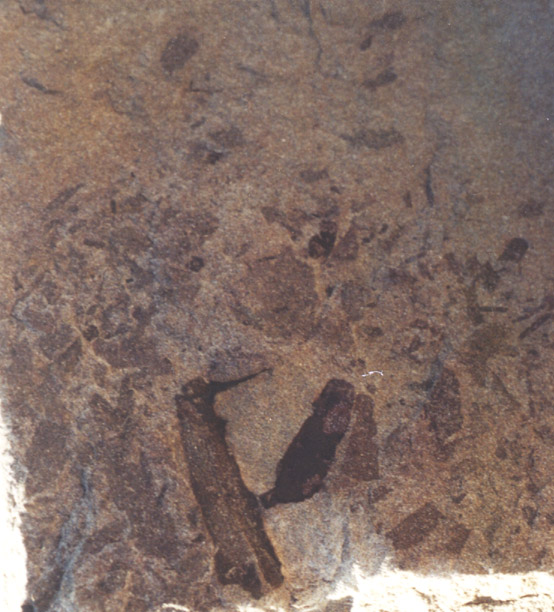
Possibilities - a spore case, or Neuropteris leaf.
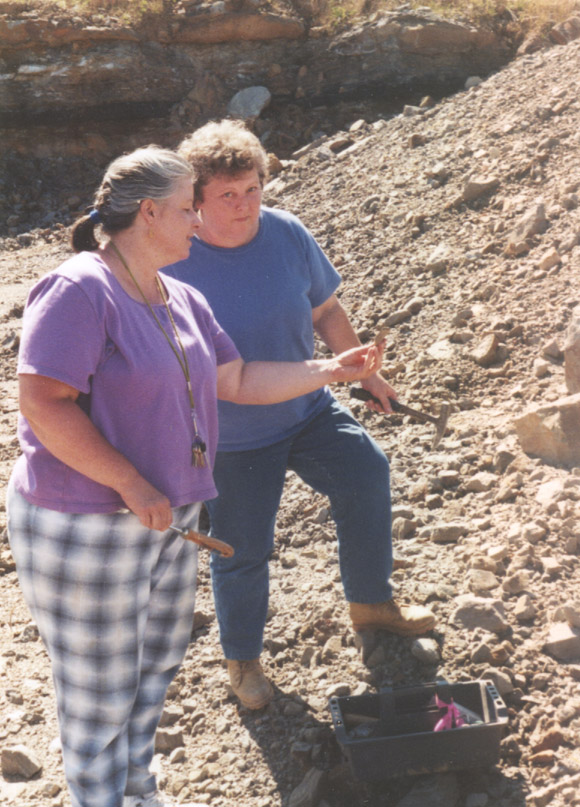
Leisa & Winnie discussing the current find.
Some fern material found at the site is shown below.
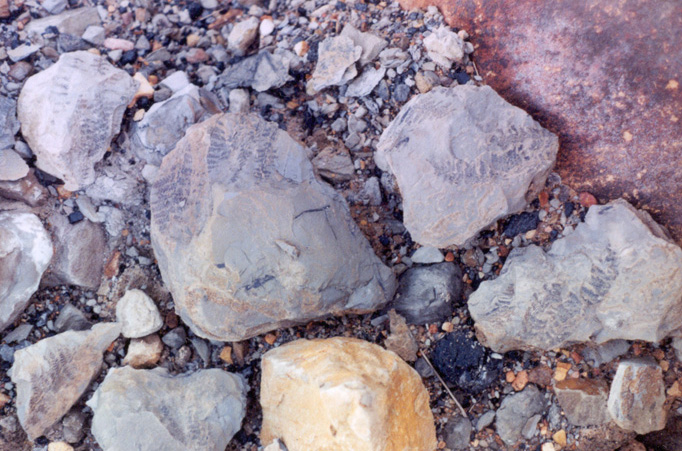
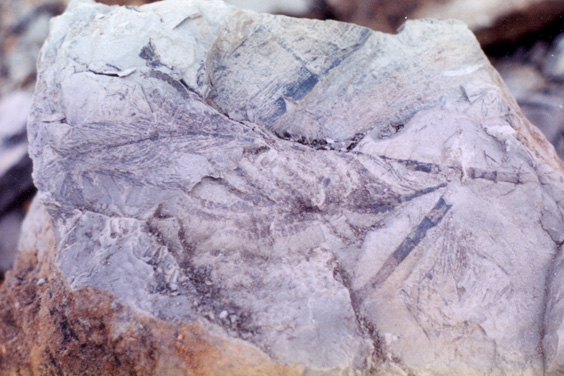
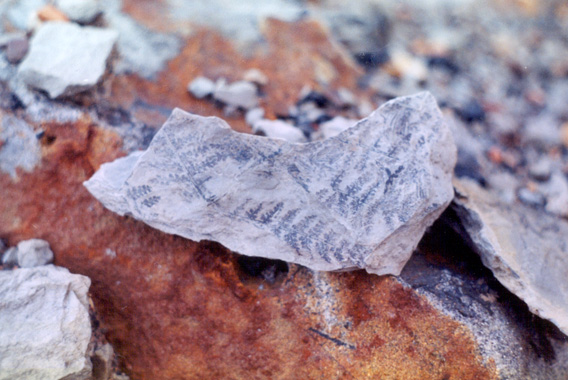
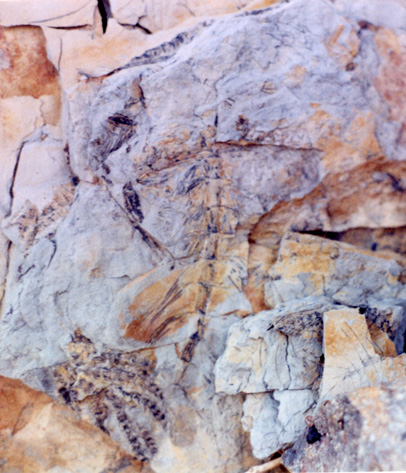
December 16, 2000 - Pennsylvanian Fossils, Walker Co, AL
by Ron Buta, Department of Physics and Astronomy
University of Alabama
Tuscaloosa, Alabama
The Union Chapel Mine is now known to be one of the best Lower Pennsylvanian track sites in North America. During December, the mine was in the process of reclamation, and the BPS returned one more time as a group to search for trackways among turned-over spoil piles in one of the most productive areas of the site. About 15 BPS members and several newcomers attended the field trip on a pleasant mid-December day.
When we arrived at the site, only one small area was not reclaimed. This particular area was one which had yielded many good tracks in the past and so we were all delighted to see that the mine workers had moved some of the old rock piles around, allowing us to see if any new material had been exposed. In spite of this, we all had difficulty finding any new high quality tracks. Nevertheless, there were still tracks to be found. I found the interesting specimen shown in Figure 1. It appears to be the trackway of an arthropod, where each track is a small roundish spot. In the significant collection of track photos which the BPS "track meets" have provided, I had not seen another set like this one. I also found the tracks shown in Figures 2 and 3. |
|||
|
|||
|
|||
| On the reclaimed areas and in the overturned area, one can still find nice plant fossils at this site. Figure 4 shows an especially nice set of ferns from a split rock. Most interesting is how strong the stem of these ferns is.
|
|||
Figure 5 shows brown ferns of the genus Neuropteris, which was common at this mine.
|
|||
Figure 6 shows a single large seed impression of a seed fern. This is how such seeds are often found.
|
|||
However, I found another rock in the overturned area having more than a dozen seed impressions. Several of these are shown in Figure 7.
|
|||
The ferns they are associated with are shown in Figure 8. Jim Lacefield discusses the seeds of seed ferns on page 66 of his new book, "Lost Worlds in Alabama Rocks", and gives a wonderful general discussion of the Coal Age in Alabama and what happened to the seed ferns.
|
|||
The reclamation of the Union Chapel Mine caps off a spectacular year of discovery for the BPS, and the Union Chapel experience marks the beginning of a remarkable cooperation between BPS amateur rock collectors and two professional organizations, the Geological Survey of Alabama and the Alabama Museum of Natural History on this new project. The more than 500 track specimens salvaged by BPS members and guests since January 23, 2000 are currently being researched by professional paleontologists. Hundreds of high quality plant fossils were also salvaged and will eventually be studied. We will no doubt be talking about the experience for years to come.
May 29, 1999 - Carboniferous Fossils - Jefferson Co, AL
Department of Physics and Astronomy
University of Alabama
Tuscaloosa, Alabama
The field trip on May 29, 1999, was to an abandoned strip mine in Kimberly that is now being re-excavated by the owner of the Warrior site which was described in the report of the March 27, 1999, BPS field trip. This is a new site for the BPS and we were most likely the first people to seriously look for fossils in the area, at least since the mine was active.
Although the postcard for the trip stated that we would be visiting the same Warrior site as on March 27, it was understood at the last BPS meeting that we would visit the new site and check it out. We decided to visit the new site first and left it as an option for attendees to visit the site on their own, since that site is much easier to find. About 15 people, including BPS members and guests, attended today's field trip.
--Edited by Vicki Lais
|
Ferns seemed less abundant, but good specimens were found nonetheless. Finely detailed fossils of the top foliage of arborescent lycopods were found in abundance. Bark impressions of Lepidodendron and Sigillaria were also found. The main difference between this site and the Warrior site is that the fossils at the latter site are concentrated in a small area that is easy to explore. At the Kimberly site, the fossils were spread out over a much larger area and finding them required a great deal of tenacious searching. Also, since you could not necessarily drive your vehicle up any of the steep hills, carrying a large fossil to your car was challenging to say the least. |
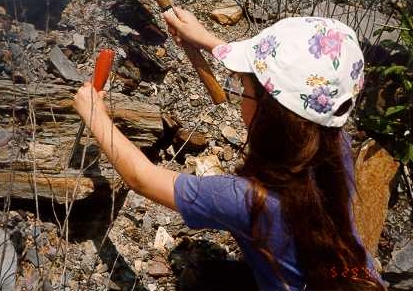 There were numerous highlights of this trip. One attendee showed me a rare (so far as I know) cast fossil of a small part of a stem of Cordaites, a gymnospermous tree with no modern relatives. The stem of this tree consists of a series of horizontal ridges and is easily distinguished from Calamites, but I had never seen one this nice before. Some very nice pieces of Calamites itself were found. The inimitable Ken Hoyle showed several of us two spectacular Calamites casts he found, each about 6 inches long and 4-5 inches in diameter. The two pieces were obviously part of the same plant, but he could not find any of the missing parts. There were numerous highlights of this trip. One attendee showed me a rare (so far as I know) cast fossil of a small part of a stem of Cordaites, a gymnospermous tree with no modern relatives. The stem of this tree consists of a series of horizontal ridges and is easily distinguished from Calamites, but I had never seen one this nice before. Some very nice pieces of Calamites itself were found. The inimitable Ken Hoyle showed several of us two spectacular Calamites casts he found, each about 6 inches long and 4-5 inches in diameter. The two pieces were obviously part of the same plant, but he could not find any of the missing parts.
|
||
Steve, Dena, and Molly Hand were also very successful in finding good 3D casts of Calamites, as well as a nice piece of Asterophyllites equisetiformis, the characteristic foilage of the branches of Calamites. Ken Wills, who previously spoke to the BPS last year, found a nice piece with many Calamostachys impressions, representing the cones of Calamites. Christina and Larry Hensley found a big rock with a stunning impression of the bark of a Lepidendron arborescent lycopod. It was beautiful but too big for anyone to carry. 3D casts of the rhizophore of Stigmaria ficoides, the root system of arborescent lycopods, were also found by several attendees, including myself. The largest, 15 inches long, was found by Bruce Relihan.
|
Particularly interesting were the stump fossils found at this site. On the top of a hill, I found three fossil stumps of Sigillaria. All three pieces showed the characteristic parallel bands of parichnos scars. The two largest pieces are about a foot in diameter and 3 to 6 inches thick. A smaller piece showed the strongest bands. I managed to get these to my car with difficulty, and needed help with one piece. Gerry Badger had a tougher time, however. He found a much bigger stump of Lepidodendron and practically had to roll it down to his car from some distant point. The stump looked to be 70-80 lbs in weight and showed weak scars. A very much larger stump was found by several others near the base of a hill. I heard it was maybe 30 inches in diameter. But by the time I heard about it, I had no energy to go and see it! Ken Wills and Bruce Relihan also found partial stump casts. In summary, this was quite an interesting field trip. When I first "scouted" out this site in April, I was not sure we would find much since casual searching during a period of one hour did not reveal many fossils. The intensive searching by attendees on this trip was much more revealing about the site, and showed it to really be nearly as good as the Warrior site. It will be worthy of a second visit in the future. |
March 27, 1999 - Jefferson Co, AL
Department of Physics and Astronomy
University of Alabama
Tuscaloosa, Alabama
The field trip on March 27, 1999 was the second organized BPS trip to a construction site near Warrior. The trip was attended by about 25 people, mainly from Birmingham, Huntsville, Tuscaloosa, the Florence area, and the University of North Alabama. Attendees included BPS members, guests, children, professors, and students, and the day was sunny, clear, and warm.
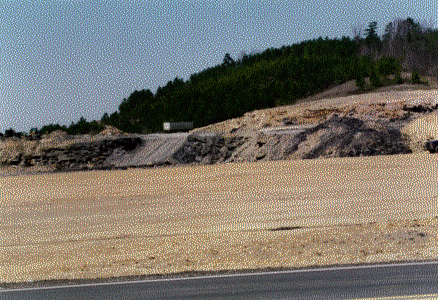 |
|
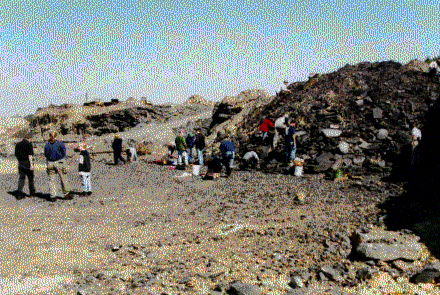 |
Fossil hunters at the main rock pile where Lepidodendron and Sigillaria specimens were abundant. |
|---|
The site was first identified as being a source of Carboniferous-period plant fossils by BPS member Gerry Badger, and the first BPS field trip to the site took place on November 15, 1997. Although various BPS members and probably others have visited the site at various times during the past year, the site has changed so much that on March 27, the site was better than it had ever been before as far as numbers and quality of plant fossils are concerned.
The most abundant plant fossils found during our most recent visit were bark impressions of the giant arborescent lycopods Lepidodendron and Sigillaria. These were mainly found in rock piles around the area of a northeast wall of rock. Large slabs showed the familiar Lepidodendron leaf scars, which look like fish scales. In many cases the scars were clear and well-defined, making the specimens extremely beautiful examples. On close inspection, the leaf scars show characteristic bundle and parichnos scars representing leaf attachment points, and many of the pieces are probably of the same species. However, after checking various books I have not yet identified the exact species at Warrior. It is clear also that more than one species of Lepidodendron is present at this site. It is also interesting that specimens of Lepidodendron at Warrior came in both direct and inverse impressions. In direct impressions, the leaf scars are raised, and are more like molds of the original object. In most pieces, however, the leaf scars are simply inverse impressions of the original raised scars, and therefore appear as depressions in the fossil.
The Sigillaria specimens are more abundant now at this site than they were on November 15, 1997. They are characterized by parallel bands of leaf scars distinctly different from the spirally arranged scars seen on Lepidodendron, although a spiral arrangement may still be present. Several species were found, but I have not been able to make exact identifications. Sigillaria specimens attendees found included not only outer bark impressions, where the leaf scars are roundish and almost overlapping, but also beautiful decorticated impressions, direct and inverse, where only parichnos scars are seen either as small spots or close pairs of small spots. These are as known as Syringodendron. The decorticated specimens are cases where the outer bark is gone, so they represent an inner bark layer. |
||
Also abundant at this site, but not necessarily found in the rock piles, were several types of seed ferns characteristic of the period. These were found at a specific level of the east rock wall less than a foot above the ground level and about 20 feet from the rock piles. The ferns found included beautiful examples of Eusphenopteris, Mariopteris, Neuropteris, and Alethopteris form genera, but I have not yet determined exact species. Because many of these were found in situ, they were still beautifully preserved with dark carbonaceous remains of the original plant material and fine details of vein systems in individual pinnules. Several attendees spent much of their time searching for ferns at the rock wall, and many were found. According to Dave Kopaska-Merkel, one young person, whose first name was Jonathan, split a large slab and found some very nice large ferns inside. Although I am not aware of any examples found during this trip, the site also is known for having Lyginopteris ferns which are distinctly different from the others. Several different species of Sphenopteris ferns have also been found in the past.
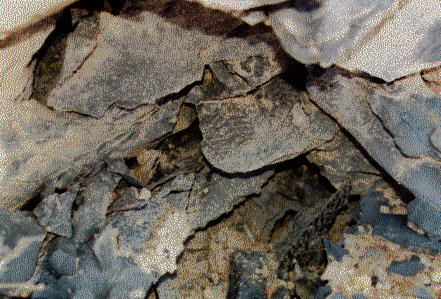 |
View of rock wall on east side of site where ferns were found in situ. |
|---|
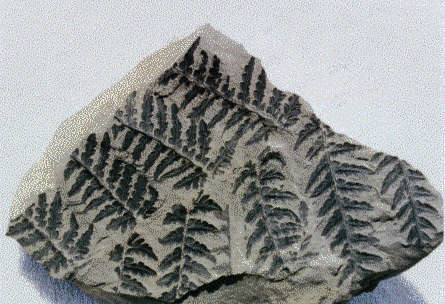 |
Typical example of a set of ferns extracted from the above part of the wall. |
|---|
Fossils of the well-known horsetail, Calamites, have also been found in abundance at this site. Several attendees (including myself) found three-dimensional Calamites stems further down the same rock wall where the ferns were found. Dave Kopaska-Merkel found a nearly foot-long Calamites specimen embedded in a larger rock. Also found were excellent specimens of the foliage of Calamites, including a fine small piece of (probable) Asterophyllites equisetiformis shown to me by Gerry Badger. At least three different species of Asterophyllites have been found at this site.
|
There were a few interesting highlights from the trip. Wayne Canis, several of his students from the University of North Alabama, and guest Richard Keyes of Huntsville, found a large and extremely beautiful example of a lycopod root system, Stigmaria, with dozens of root impressions emanating from the sides and clear deep small depressions or root scars on the main body, known as a rhizophore. The fossil was so fragile that Richard went off site to buy a can of spray glue to insure the piece would hold together during the drive home. Also found today were large fossil "stumps" and logs of arborescent lycopod stems. Gerry Badger located a 64 pound stump in the one of the upper rock piles at the site, and Wayne Canis and one of his students each found a similar piece. Particularly interesting was a long, nearly vertically-standing log found in an upper rock wall near the back of the site. Except for the log, no other fossils were obvious in this wall. Gerry Badger heroically tried to get the main body of the log off with a hammer. This
was at great risk since the specimen was under a large rock overhang! The job was not easy and afterward I saw the specimen in pieces in the back of Gerry's car, but he still was upbeat about it.Later, I found another stump fossil in a rock wall on the north side of the main site level. It, too, was the only fossil noticed in that particular area, although several of us thought we saw the end of a highly flattened stump still in the wall but much higher up in the same area. The stump I found is about a foot long and weighs 77 pounds. Unlike the others found, it is covered with hundreds of small scars and impressions, indicating a fairly definite identification as an arborescent lycopod cast. These "stumps" and logs represent cases where a hollow cavity left by the stem was filled with mud which later solidified and preserved the general shape as well as any inner details. They are not "petrified" in the usual sense.
In summary, this field trip was a very enjoyable experience for all who attended. On a wonderful day, we all experienced a part of Alabama's past and took home the beautiful relics of a bygone era of Alabama natural history. |
||||||
 |
Group working on Stigmaria fossil near road to upper level of site. |
|---|
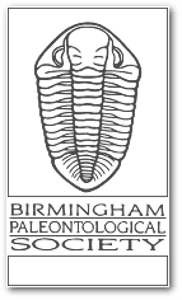
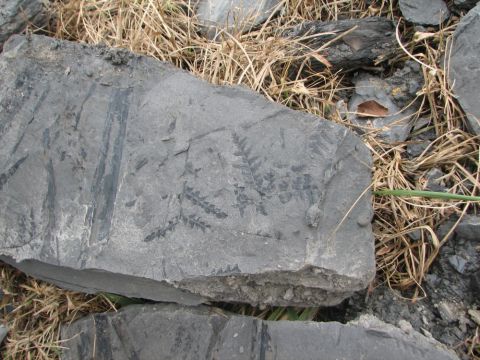

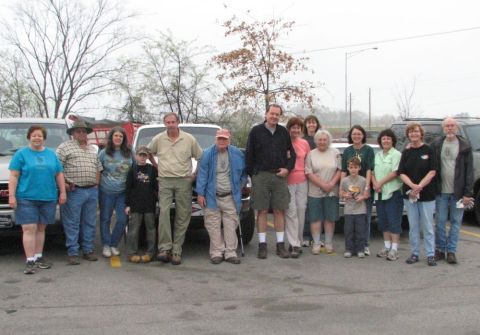
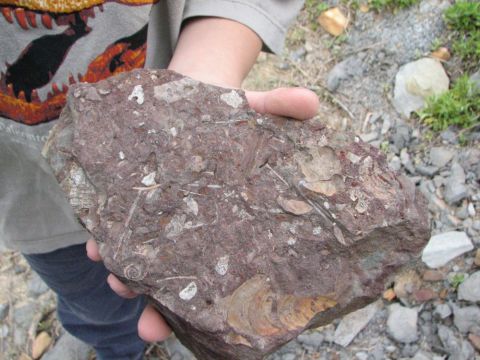
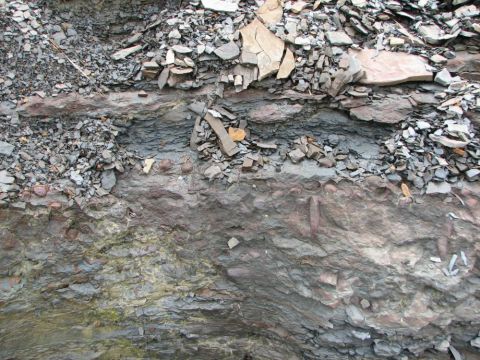
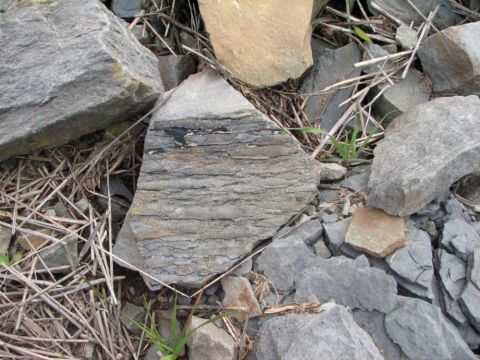
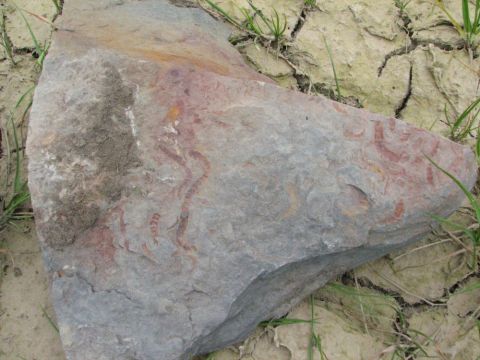
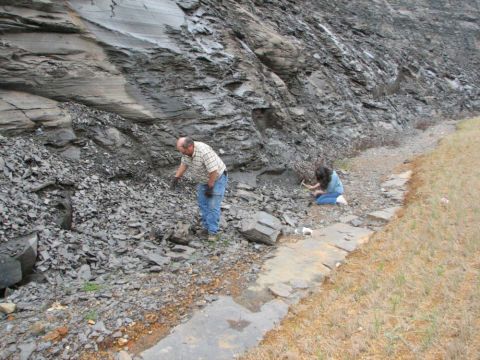
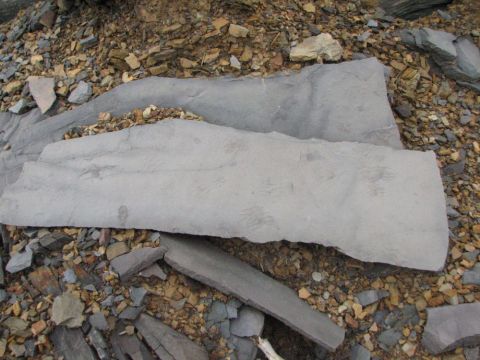
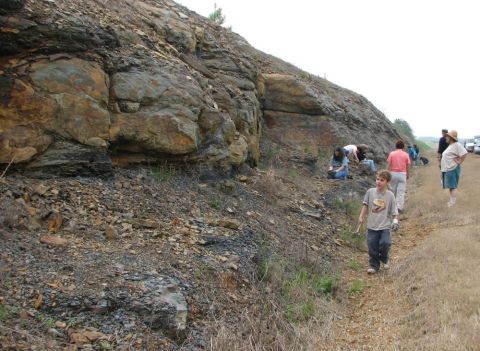
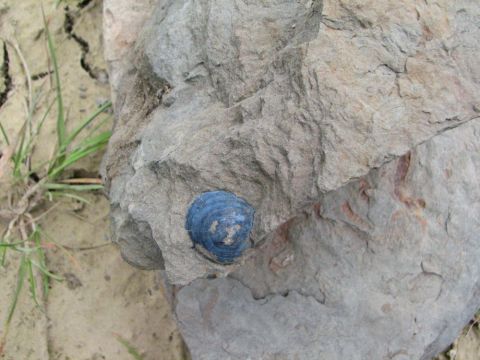
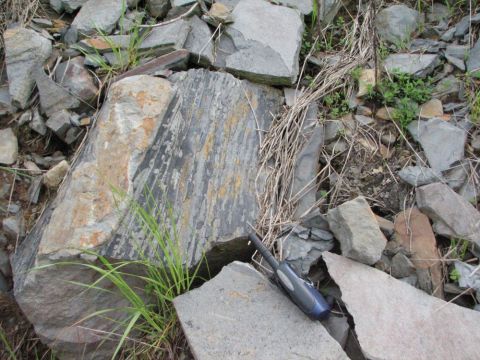
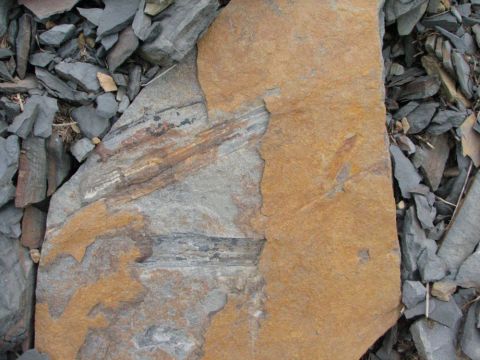
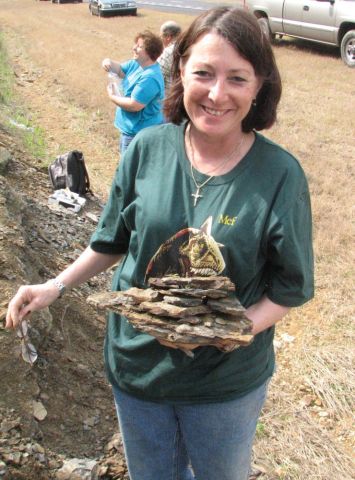
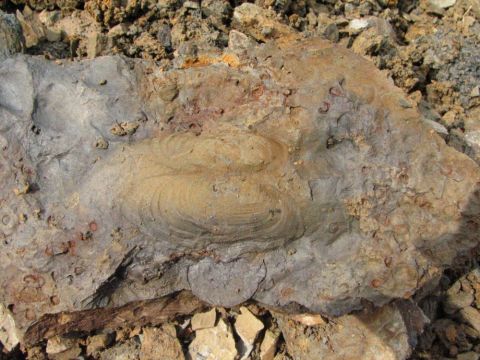
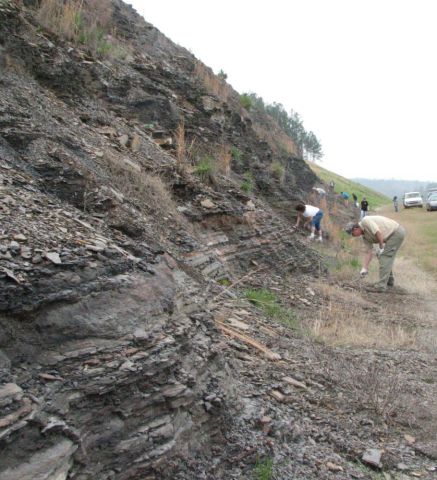
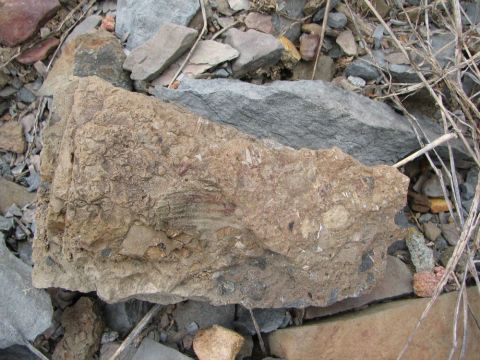
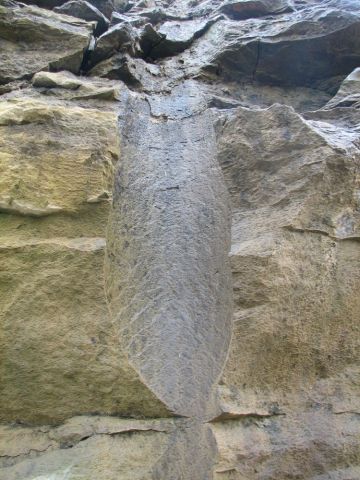
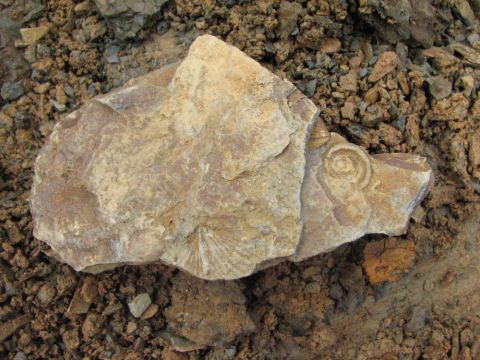
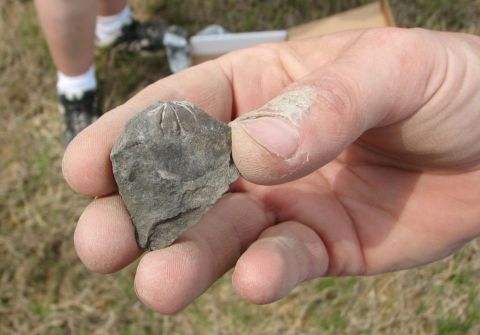
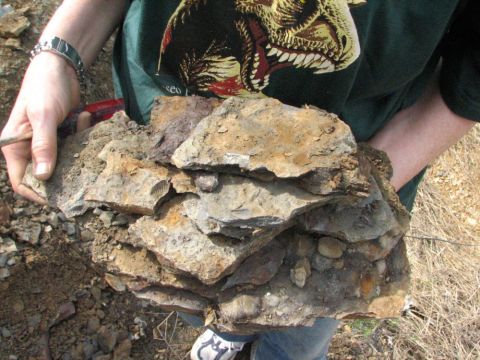
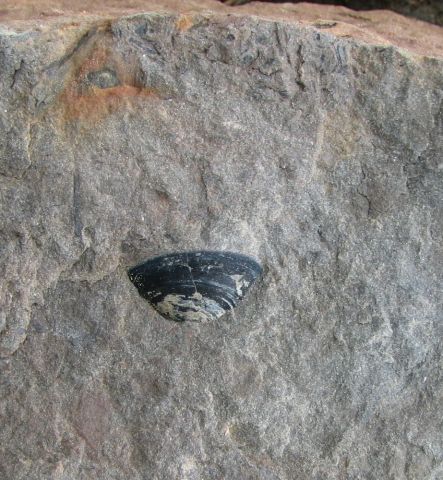
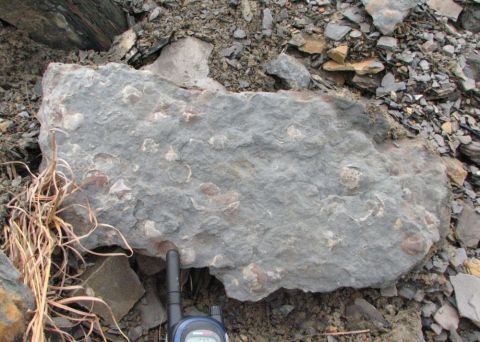
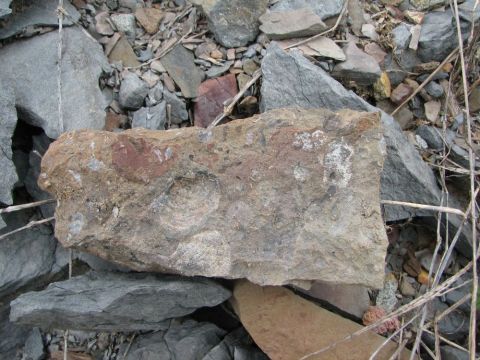
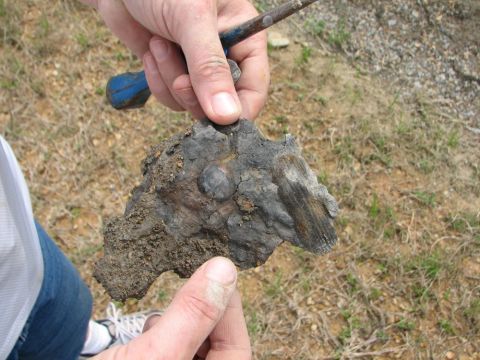

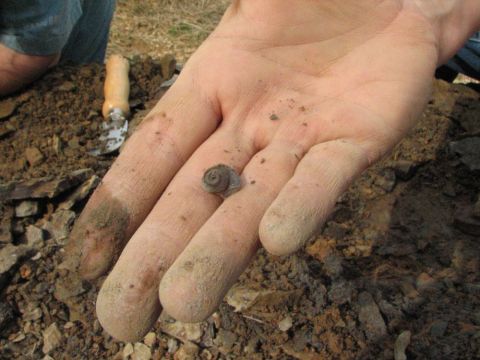
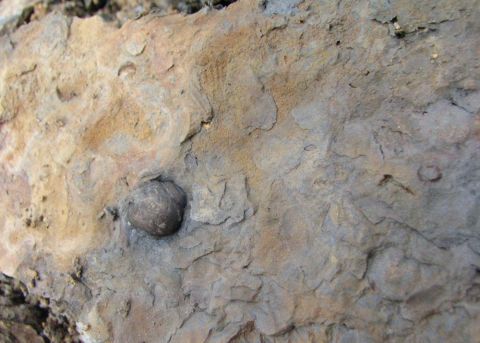
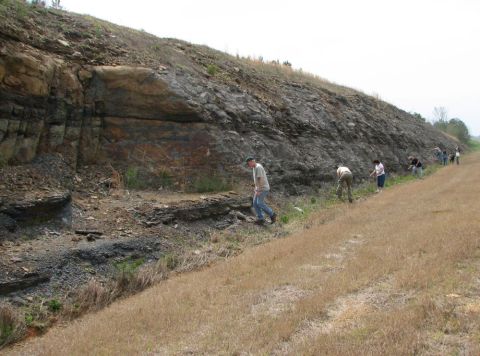
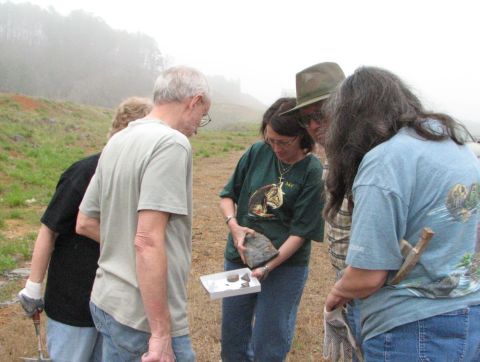
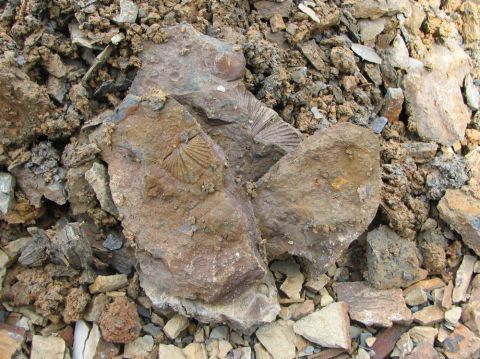
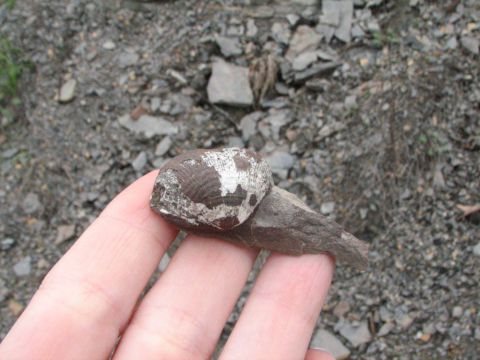
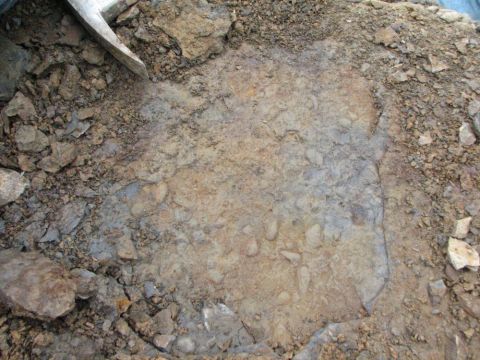
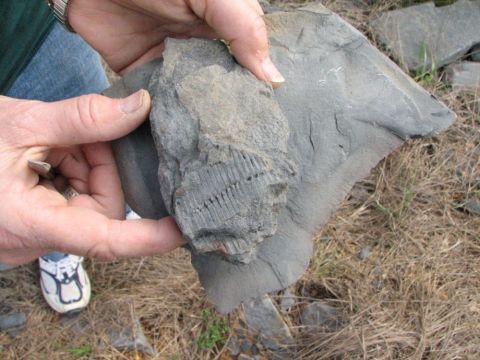
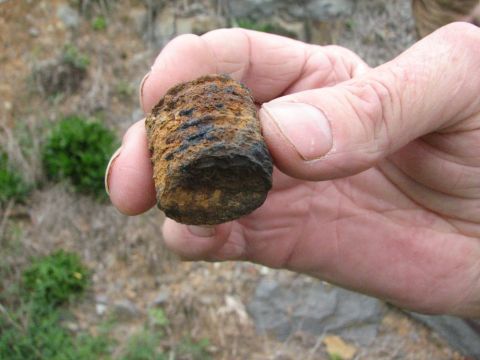
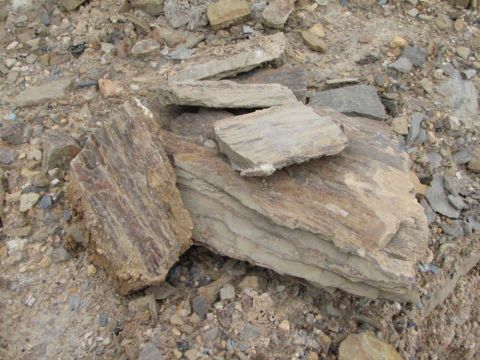
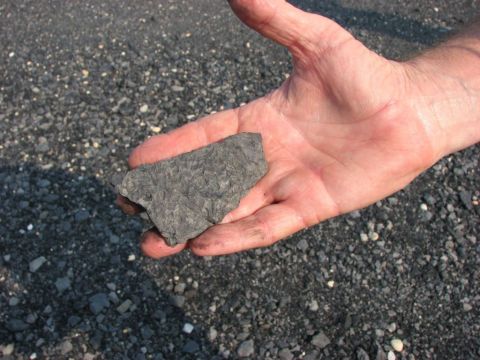
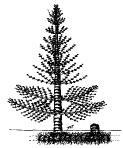
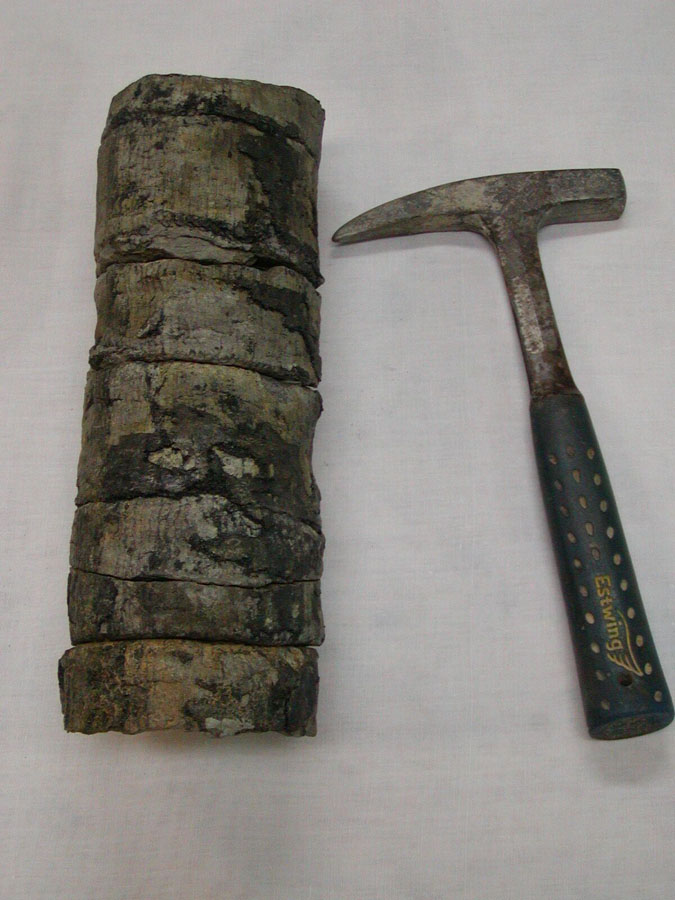
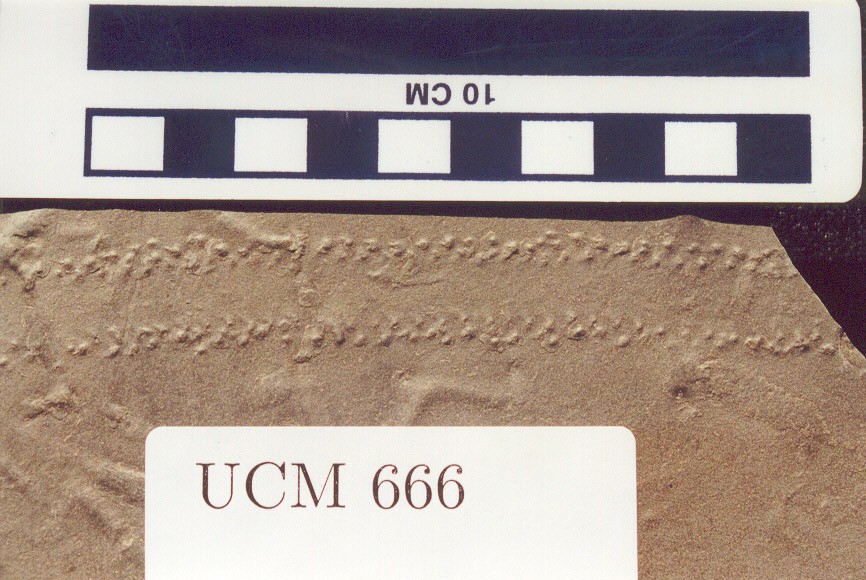
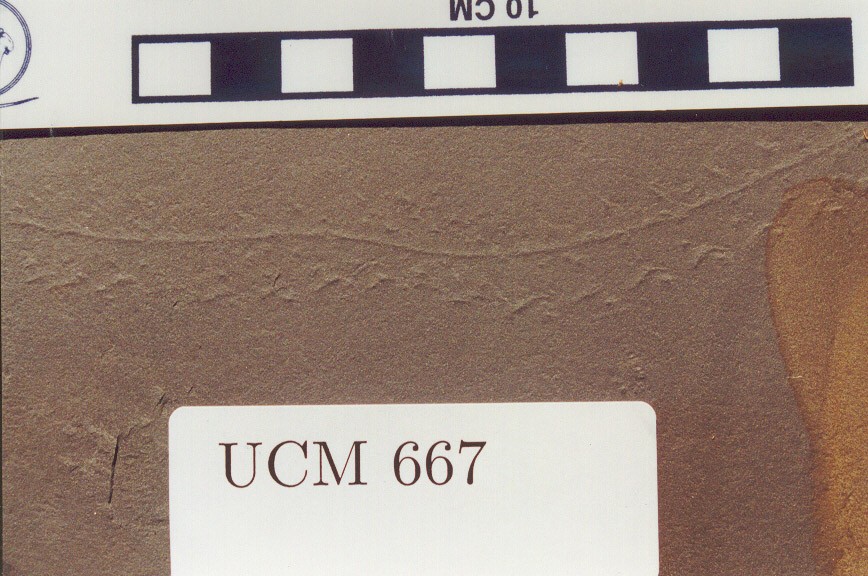
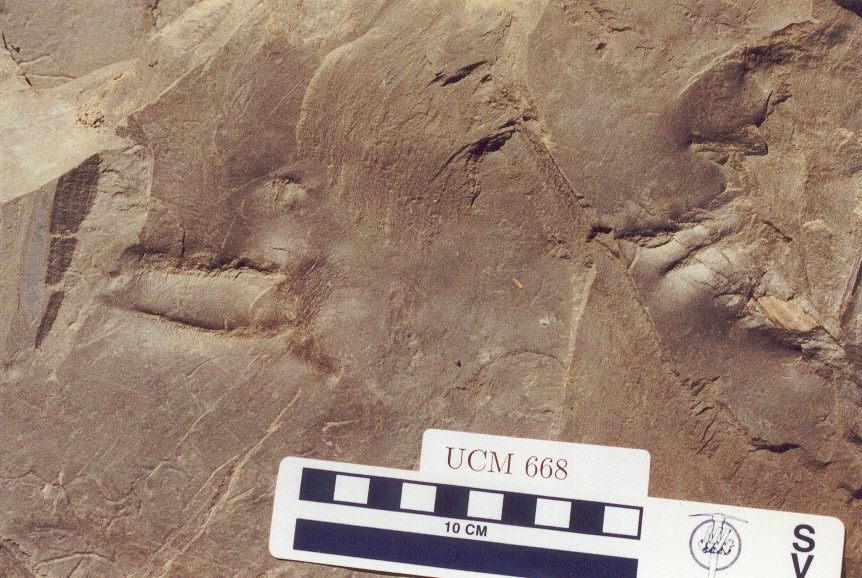
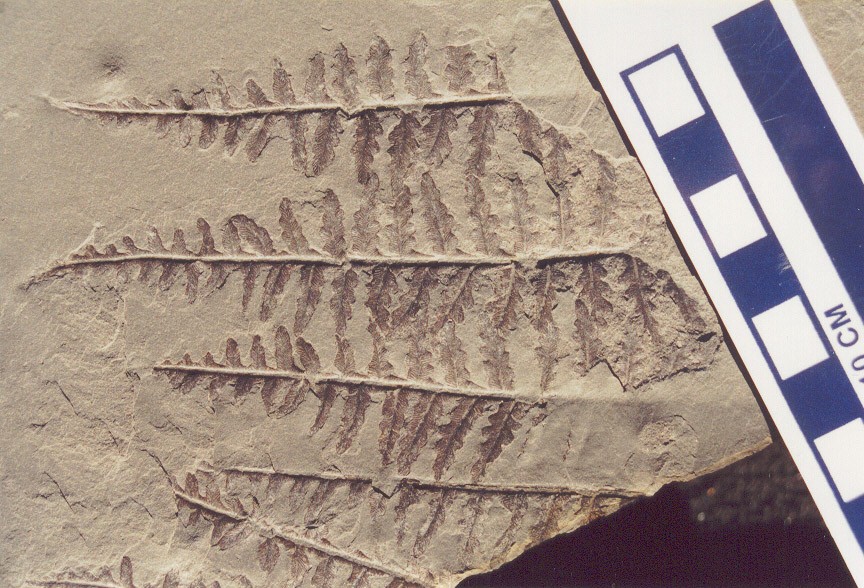
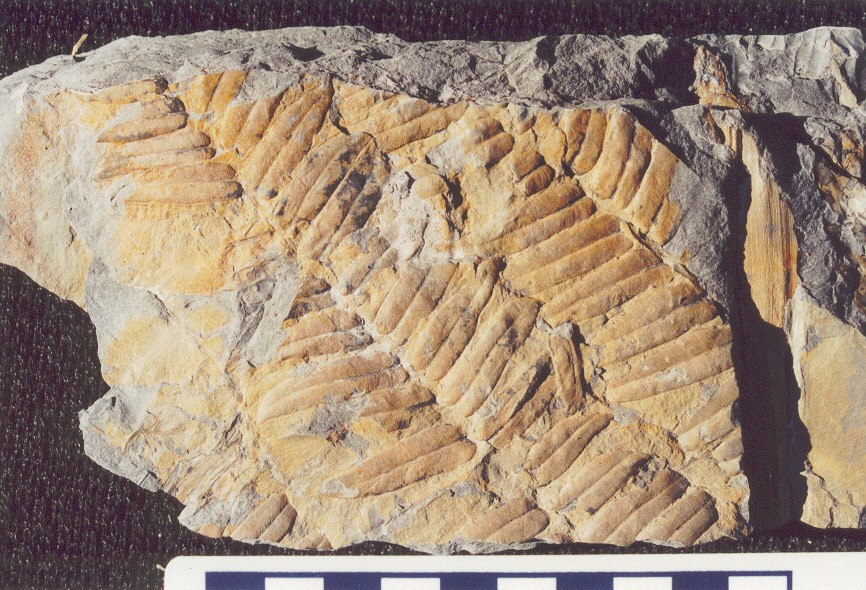
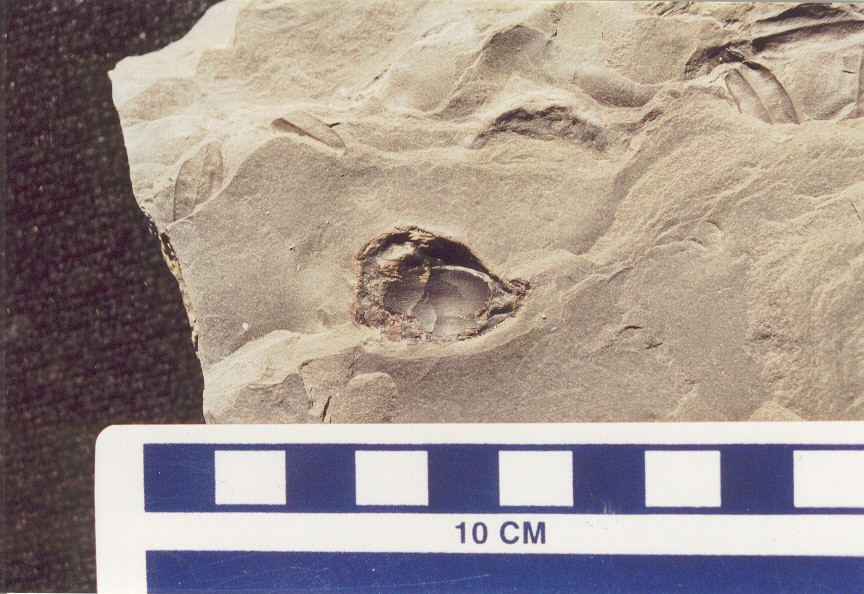
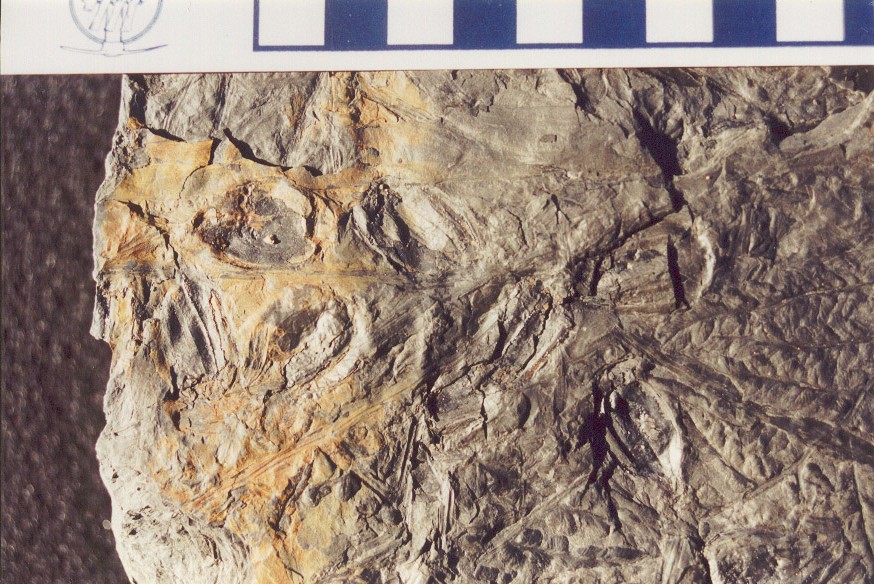
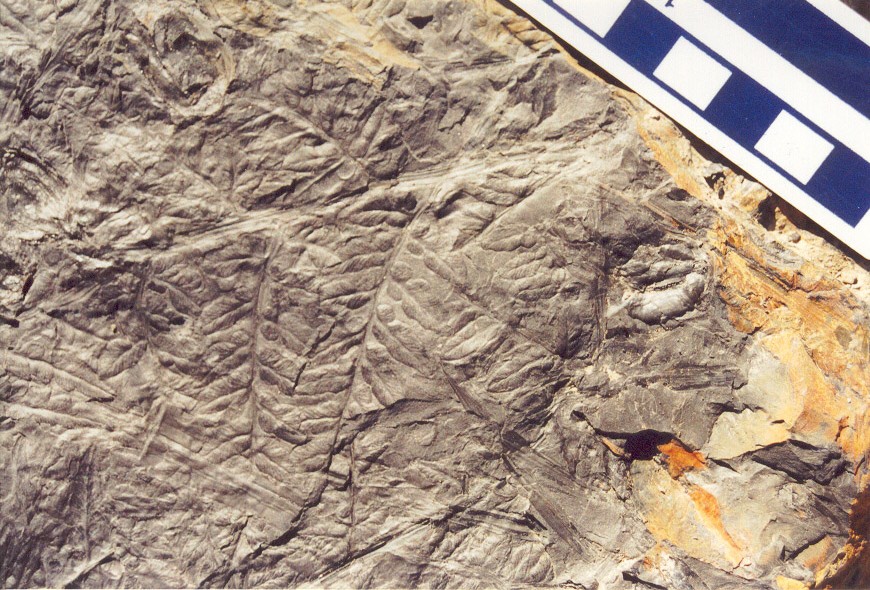
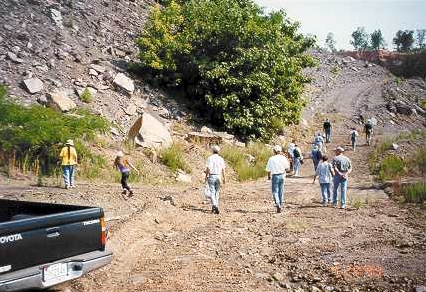 The site turned out to be a particularly good one for finding a variety of Carboniferous period plant fossils. The area was so vast that even with 15 people we really did not explore it all. Many rock piles surround an open area where we could park our vehicles. Fossils of Calamites, including 3D stem casts, stem impressions, foliage, and cones were abundant in some areas.
The site turned out to be a particularly good one for finding a variety of Carboniferous period plant fossils. The area was so vast that even with 15 people we really did not explore it all. Many rock piles surround an open area where we could park our vehicles. Fossils of Calamites, including 3D stem casts, stem impressions, foliage, and cones were abundant in some areas.